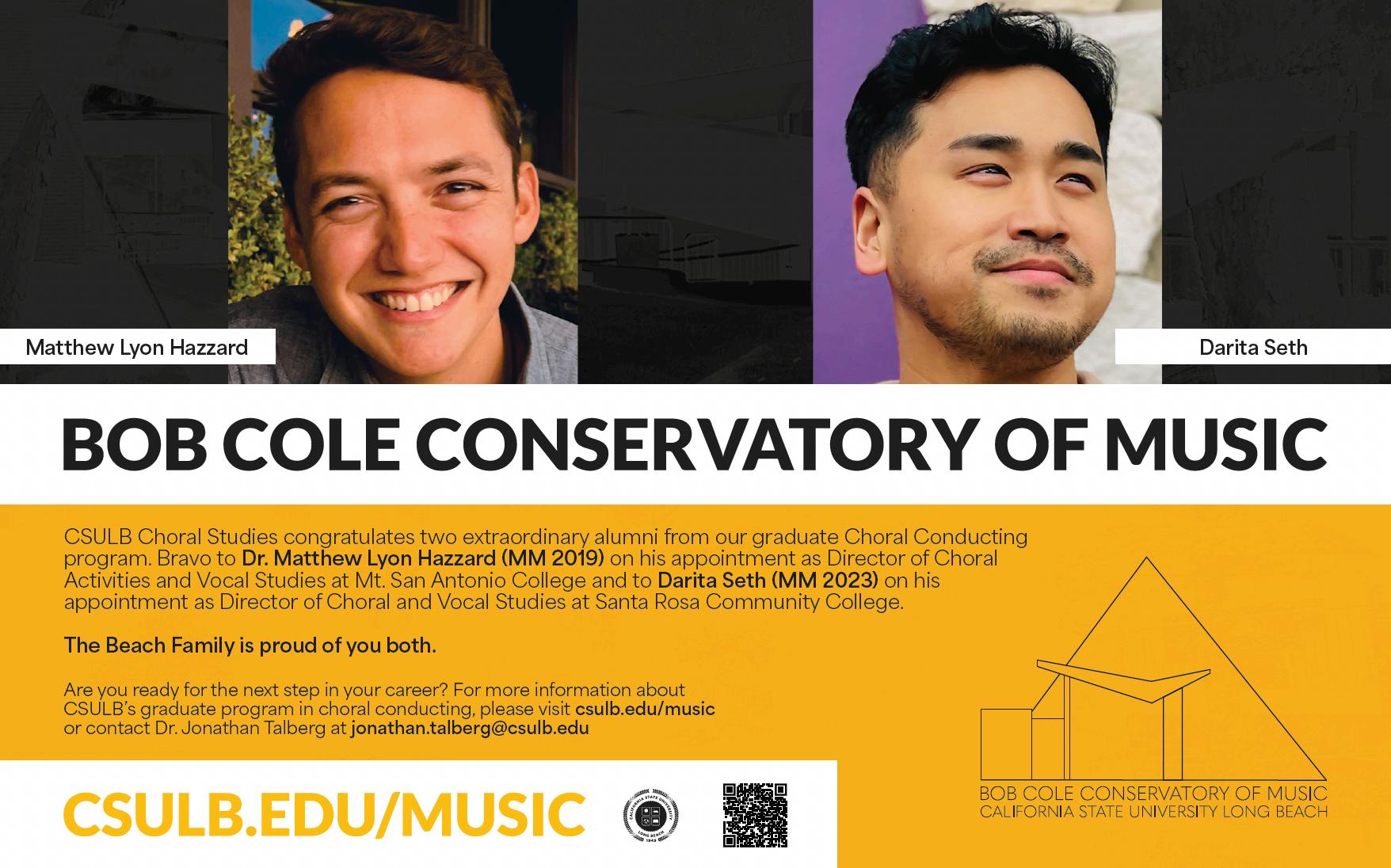












Western ACDA Board Executive Committee
Julie Dana, President
Aimee Stewart, President-Elect
Michael Short, Past-President
David Sonnichsen, Treasurer
Lynn G. Atkins, Jr. DEI Initiatives Chair
Naomi Gamez Penciu, Recording Secretary
Laurie Hancock, Membership Chair
State Presidents
Katie Gerrich, Arizona President
Arlie Langager, California President
Chris Serrano, Hawai‘i President
Jennifer Lowry, Nevada President
Emily Mercado, Utah President
Communications Committee
Elizabeth Baker, Marketing and Communications
Anna Caplan, Webmaster
Olivia Arnold, Tactus Editor
Western ACDA Board Advisory Committee
Marcela Molina, Youth R & R Coordinator
Andrew Howden, Senior High School Co-Chair
Laura Ramirez, Senior High School Co-Chair
Joanna Habermann, Junior High/Middle School Co-Chair
Jennifer Lowry, Junior High/Middle School Co-Chair
Leslie Walker, Children and Community Youth
Cynthia Salomonson, Elementary Choir
Stephanie Council, College and University Coordinator
Aaron Humble, 4 Year College Chair
Michael Huff, 2 Year College Chair
Rachel Samet, Youth & Student Activities
Ryan Holder, Repertoire Specific Coordinator
Tina Paulson, SSAA Chair
Andrew Howden, TTBB Chair
Ángel Vásquez Ramos, World Musics and Cultures Chair
John Knutson, Vocal Jazz
MaryAnne Muglia, Contemporary A Cappella
Diversity, Equity & Inclusion Committee
Nicky Manlove
Miguel Chicas
Juan Jose Garcia
Yu-Feng Huang
Josh Palkki
Front page images sourced from the Library of
Arizona: Carson Desert, 1867, Two people sitting by Alkali Lake
California: Redwood National & State Parks, November 1934, Redwood clearing along roadside
Hawai‘i: Mauna Loa, July 1899, Stones and lava captured in an eruption of Moku‘āweoweo
Nevada: Boulder City, 1980-2006, A view of Lake Mead
Utah: Washington County, c 1968, Upper Pine Creek Bridge on Zion-Mount Carmel Highway
Dear Readers,
Happy Fall! I hope that this season brings you new musical opportunities and memorable experiences with your singers To aid you in planning repertoire, we bring you a special repertoire and resources issue of Tactus! Current R&R chairs curated diverse lists of music from a variety of genres appropriate for singers of all ages Repertoire lists are organized first by age group, then alphabetically
Readers, I hope that you find repertoire and knowledge in these pages to help carry you successfully through the rest of the year. If I might suggest a takeaway from this issue, it would be to be open and welcoming to someone or something new. Try a new work, explore literature by a newfound composer, be inspired to try choral music from another country or culture, or connect with a living composer with commission ideas!
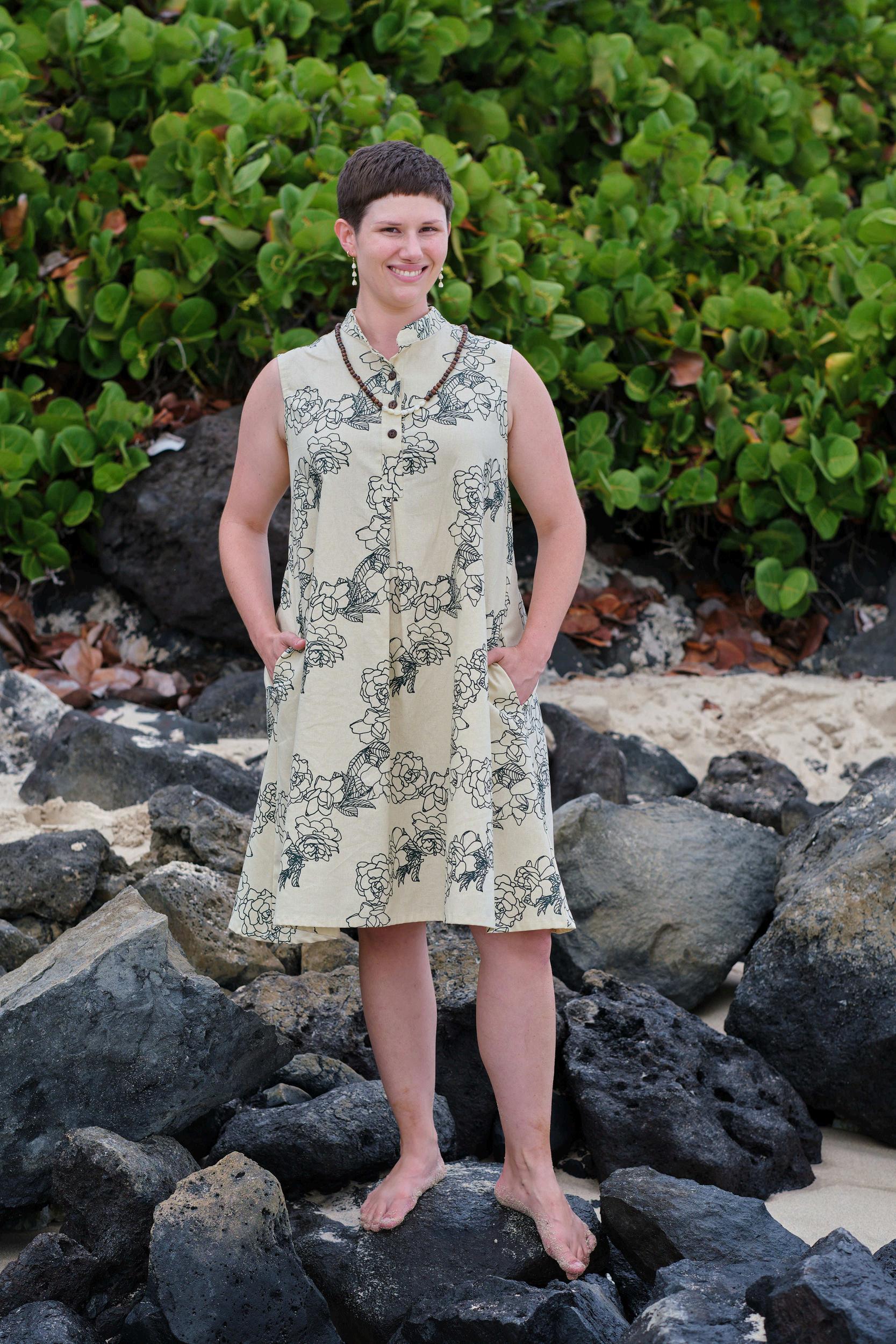
As always, feel free to email me at tactuseditor@acdawestern org
All the best,
Olivia Arnold Tactus Editor
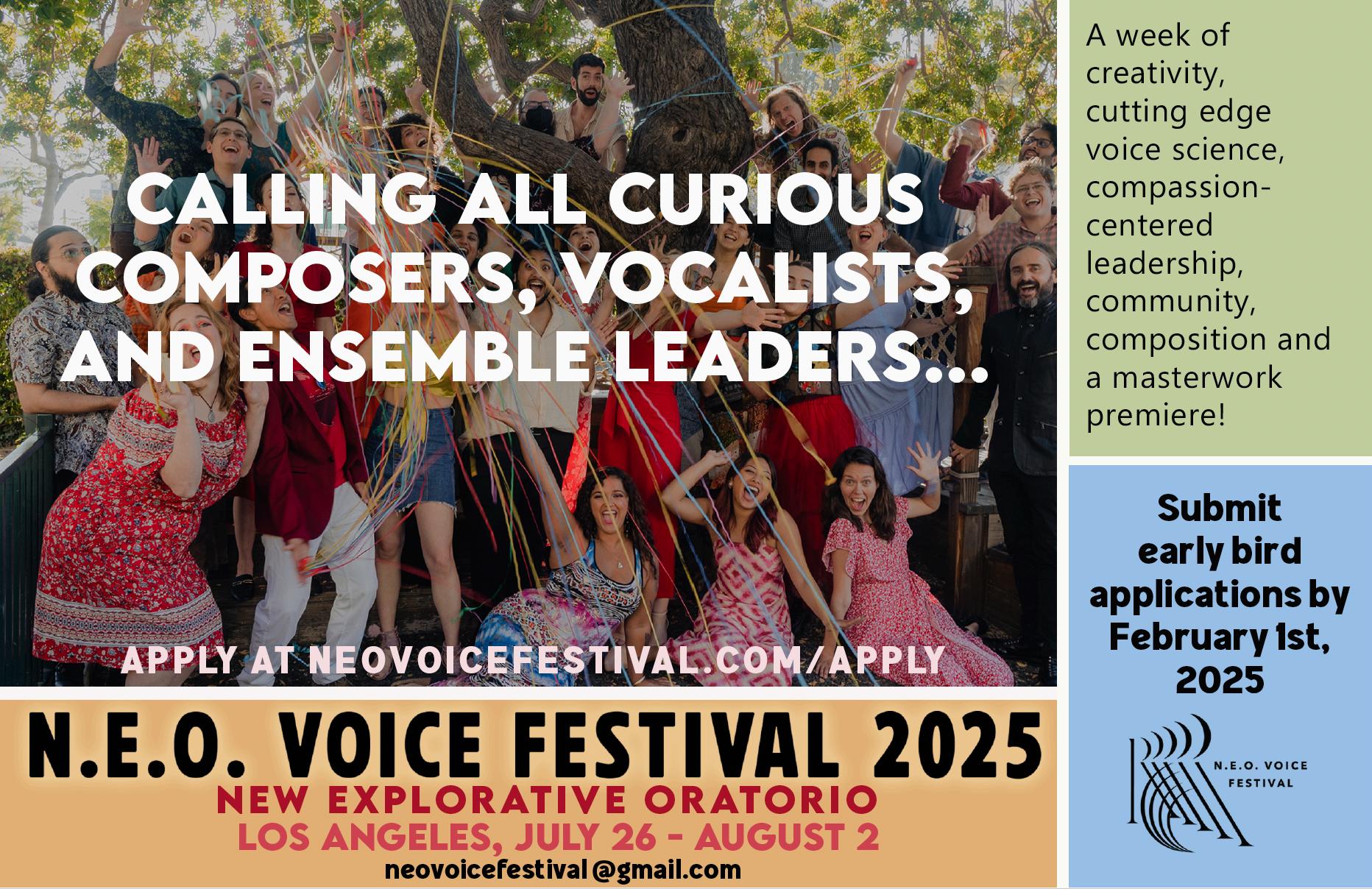
“Everybody look around 'Cause there's a reason to rejoice you see Everybody come out And let's commence to singing joyfully… Can’t you feel a Brand New Day? ”
- “The Wiz”
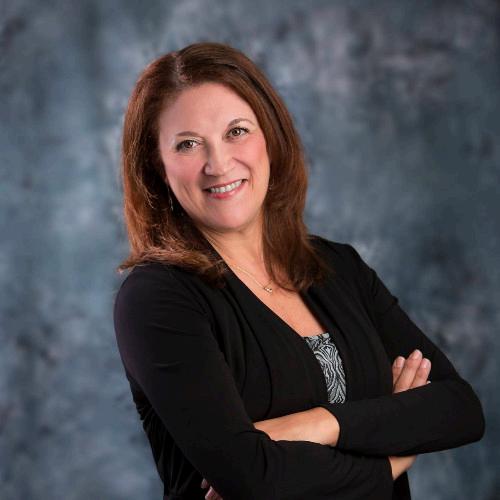
I was in high school when this show opened, but I never truly understood the music until I purchased an octavo for my choir to perform (with ‘choralography’) at a pops concert. I remember “The Wiz” in every transition time of life. For me, change is exciting, terrifying, and stressful all at once. It is almost always a positive part of my human growth Often the hardest part is deciding to actually make the change (if it wasn’t decided for me already). But, I always end up feeling the joy of a ‘brand new day’!
When I entered the role of Western Region President, it was a reason to rejoice! Mike Short and I have been friends for many, many years, with our choral connections taking us back to working on state and regional honor choirs, singing in caroling groups, conferencing, and sharing in the joys and challenges of being secondary choral educators As Mike earns his well-deserved rest in his past-president role, I thank him for envisioning a journey in Pasadena and for paving the way for the 24-26 board to pick up the baton to continue forward. Thank you, my friend; I am honored and grateful to still be serving with you after all these years! Thank you to Mike, Lou, Kim, Travis, Anna, and many more
By the time you read this, our board will have been working for 3 months or so on developing creative ways to provide information, resources, and connections for the membership in our five states. Our state presidents are working with the Western Executive Board to open communication lines and serve the many needs of our region. I recently read the 2024 conference surveys and we will take suggestions forward as we plan the 2026 conference in San Jose One comment especially tugged at my heart strings: “I would really like to be involved in helping with things such as conferences but it seems challenging to have that opportunity.” If you desire to be involved, there are open arms awaiting you!
Please reach out to any of your Western Region Board
members through the WACDA webpage and let them know how you would like to be involved Another “Brand New Day” moment was emerging from the pandemic! Through lockdown, our ability to connect grew stronger Can we meet online and discuss issues central to our particular area? Yes. Can we access and share information for the benefit of any member in a unified location? Yes. Do any of us have computer PTSD and not want to use that device unless absolutely necessary? Likely, also yes…. (I did not walk into the room I taught from during the pandemic for about a year after unless I absolutely needed to be in there ) Post-pandemic, another verse of “A Brand New Day” comes to mind:
Everybody's glad 'cause our silent fear and dread is gone. Freedom, you see, has got our hearts singing so joyfully. Just look about….You owe it to yourself to check it out, Can you feel a brand new day?
We are all part of this amazing community that works to celebrate choral music We bring our song from various backgrounds and experiences, from cultures on Pacific islands and on reservations on our mainland; we are lovers of collaboration, community, history, and the peace that music brings to the world Each of these is a brightly-colored thread of song, woven into a tapestry of our collective voices.
I look forward to the journey ahead as we lead choirs and audiences through transformative choral experiences. I encourage you to listen to the voices of our past, upon whose shoulders we now stand I encourage you to invite colleagues to experience the camaraderie and fellowship of ACDA I encourage you to accept that invitation from a new teacher in your area and attend their concert We can make a difference with small acknowledgments of our connections. Remember, we are YOUR board, we are here for you. I look forward to sharing plans for our 2026 Western Region Conference “A Tapestry of Voices” in San Jose, CA March 4-7 and look forward to seeing you in Dallas at the ACDA National Conference this spring
Wishing you all the joy of your own ‘brand new day’!
BY JULIE DANA
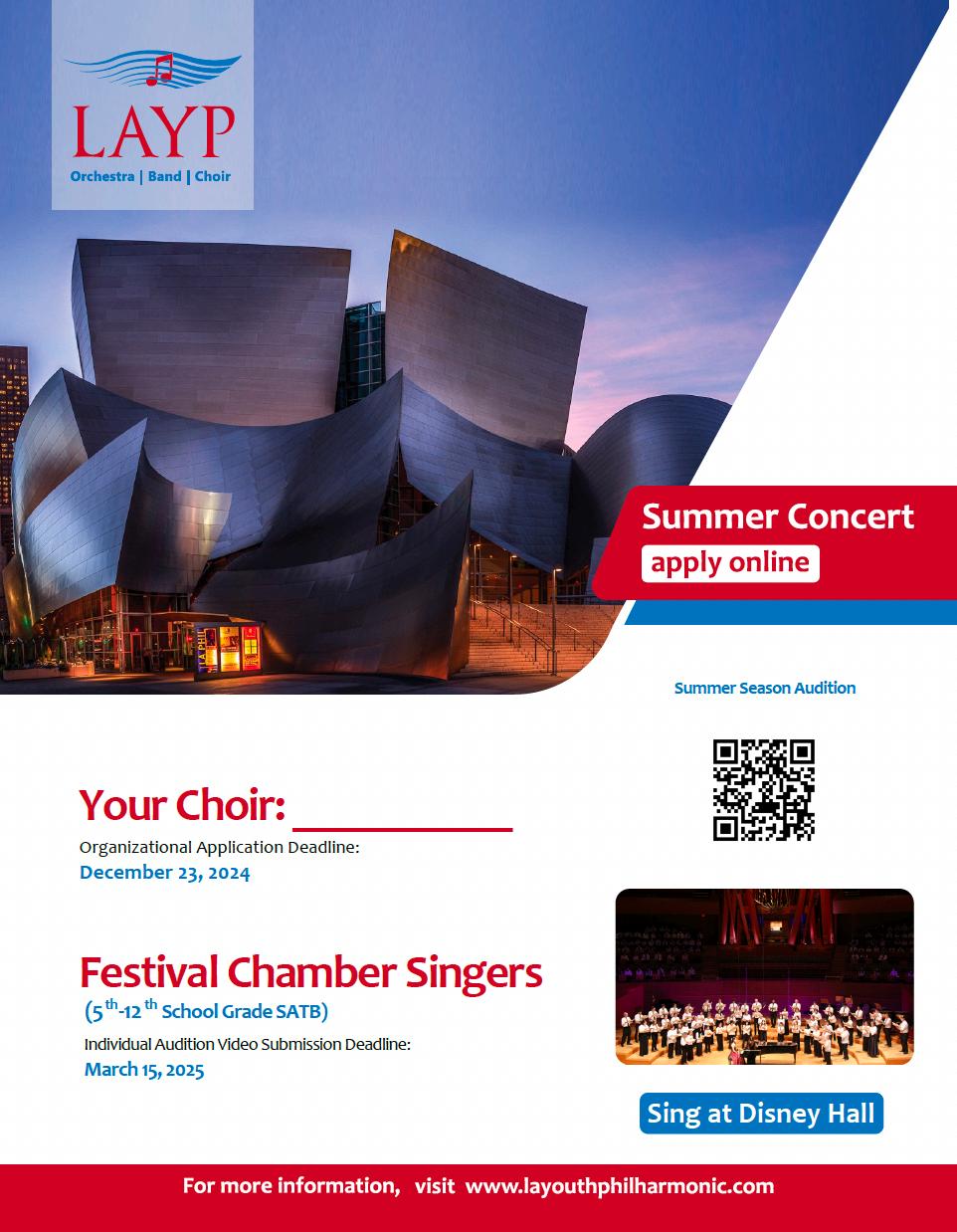
Why your young singers should participate in
their own words!
BY AIMEE STEWART
Have you ever considered auditioning your youngest singers for the Children’s Honor Choirs through ACDA? There are amazing opportunities for these young musicians that are rare to find through other avenues. While the Jr. high honor choirs are usually quite competitive and opportunities abound for high school choir singers, the ACDA National Children’s Honor Choirs offer a rare chance for our young choristers to have early experiences that are truly impactful and extremely inspiring. Over the next few issues, watch for further Tactus articles that will include several tips, tricks, and guides for how to encourage your elementary aged singers to be involved in National or Regional Honor Choirs To kick this off, I invite you to read what my students had to say about their experiences in National Honor Choirs throughout the years They would always come home brimming with excitement about their experiences, which fed a positive energy in our home choirs You’ll notice many of these singers went back for several honor choirs!
What choir were you in and how old were you?
I was 10 years old [when I participated in the Cincinnati Children’s Choir in 2023]
- Amber R
I was in the [2015 Salt Lake City] Children’s Choir when I was 10 and the [2019 Kansas City] Jr. High/ Middle School Honor Choir when I was 15 years old!
- Brisbynne A.
I was 11 years old and in the [2015] Children’s choir I was in 5th grade at the time
- Isabel G.
I was in 4th grade, 9 years old at the [2 City Children’s Honor Choir, which was In 2019 I was in 8th grade, 13 years old a Kansas City, MO] Children’s Choir whic grade
- Ivy S.
(Ivy S also participated in the 2023 Ci Gospel Choir)
I was 13 in the [2019] middle school hon was a really fun experience. I was ner didn’t practice enough but I learned al time. I made some friends who I still ha today and that was really fun The mo thing for me was worrying that I would for not knowing the music but I think I w to that thinking back I think any kid wh and singing would have a great time
- Josh T
(Josh T. also participated in the 2015 Children’s Choir and 2023 Cincinnati Go

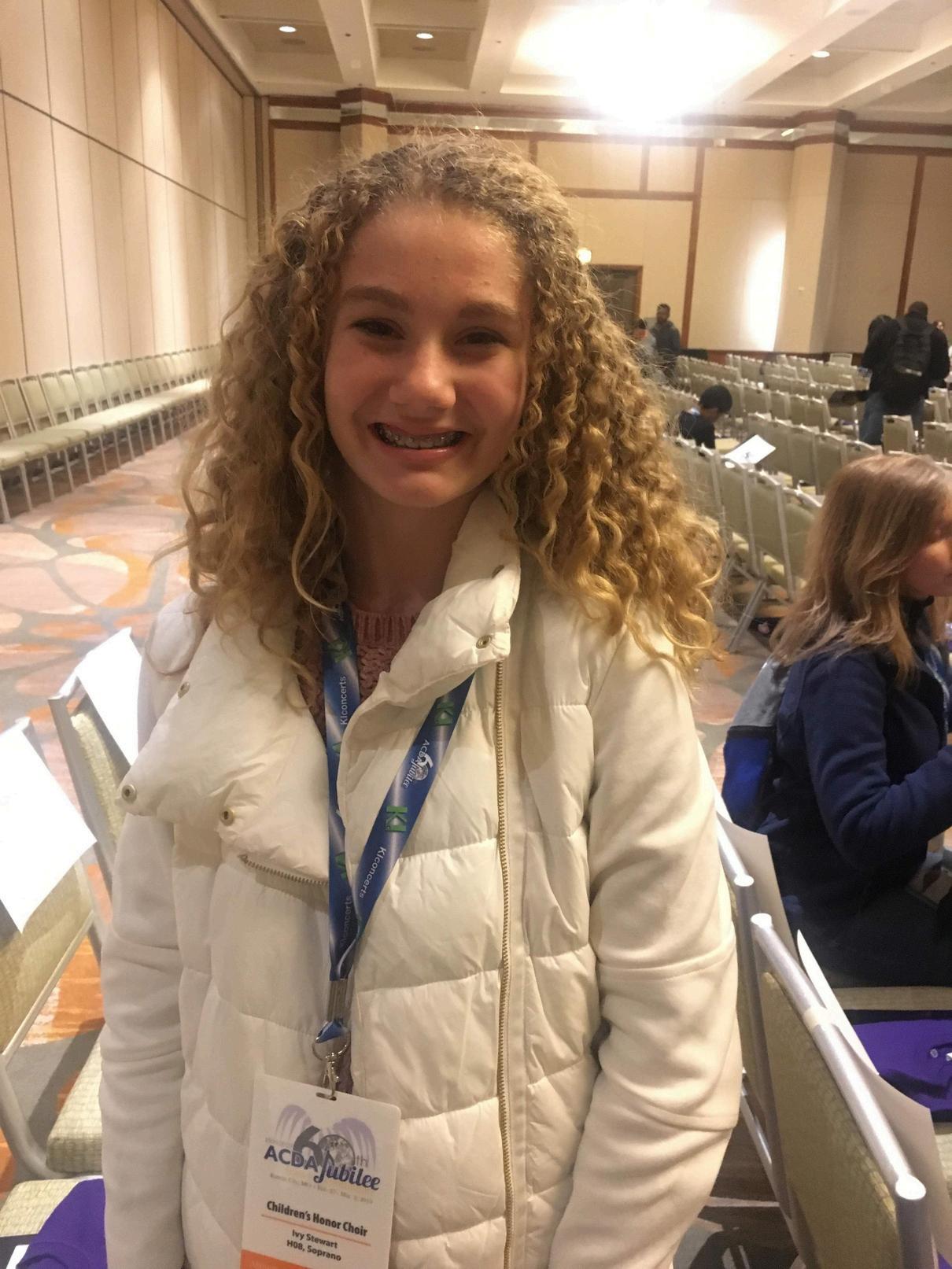
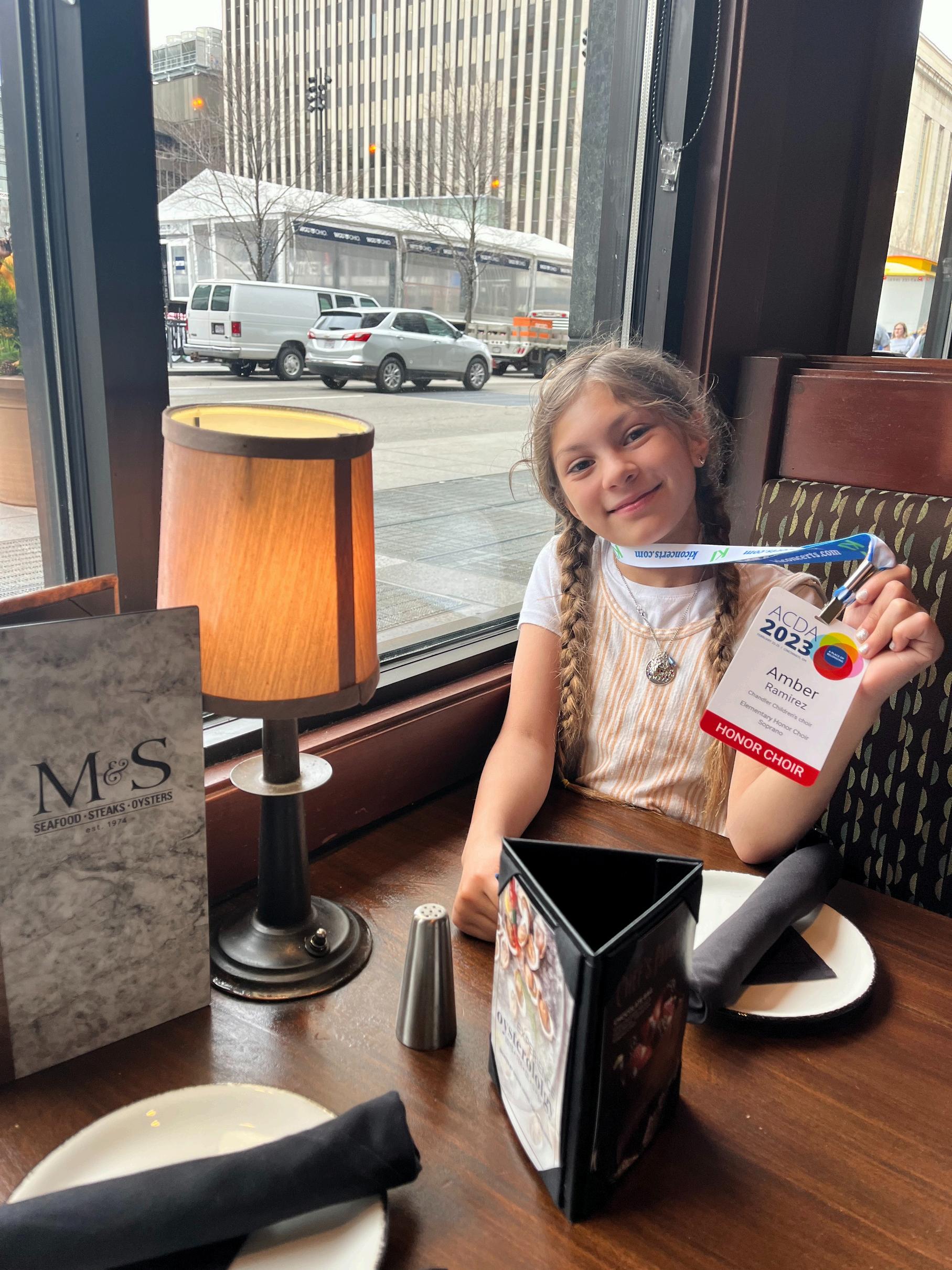



My experience going to honor choir in Cincinnati was FUN! We got to sing all different types of songs and made new friends. - Amber R.
I absolutely loved being able to sing in a choir that had such crazy amounts of talent! I enjoyed the challenge that came with being in a National Choir and seeing the results of all the time spent practicing the songs pay off in the concert at the end of the week! - Brisbynne A
I loved doing choir conferences. I always learned so much from the directors about singing, musicality, music appreciation, choir etiquette , and other related topics. I always remember the first time the choir would get together and hearing our sound for the first time. It was such a special moment And in a choir of 200 people, more or less, that sound was always pretty glorious And of course we always were told that director cliche of how this group of these people will never be in a room together again and how this sound we are creating is unique to these people and this moment. And while it always seemed cheesy, it’s true, and it is something to cherish in the moment. - Isabel G.
In the 4th grade choir, it was so much fun. I was with a bunch of my friends in a place that I was familiar with in Salt Lake City I remember it was snowing and it was just a really fun experience We did one song called “The Kookaburra” and it was so fun to sing I remember in rehearsals we practiced all the bird sounds In the 2019 choir in Kansas City, it was super cold in February which also made it exciting because I wasn’t used to that. I loved that the whole experience wasn’t a vacation It was
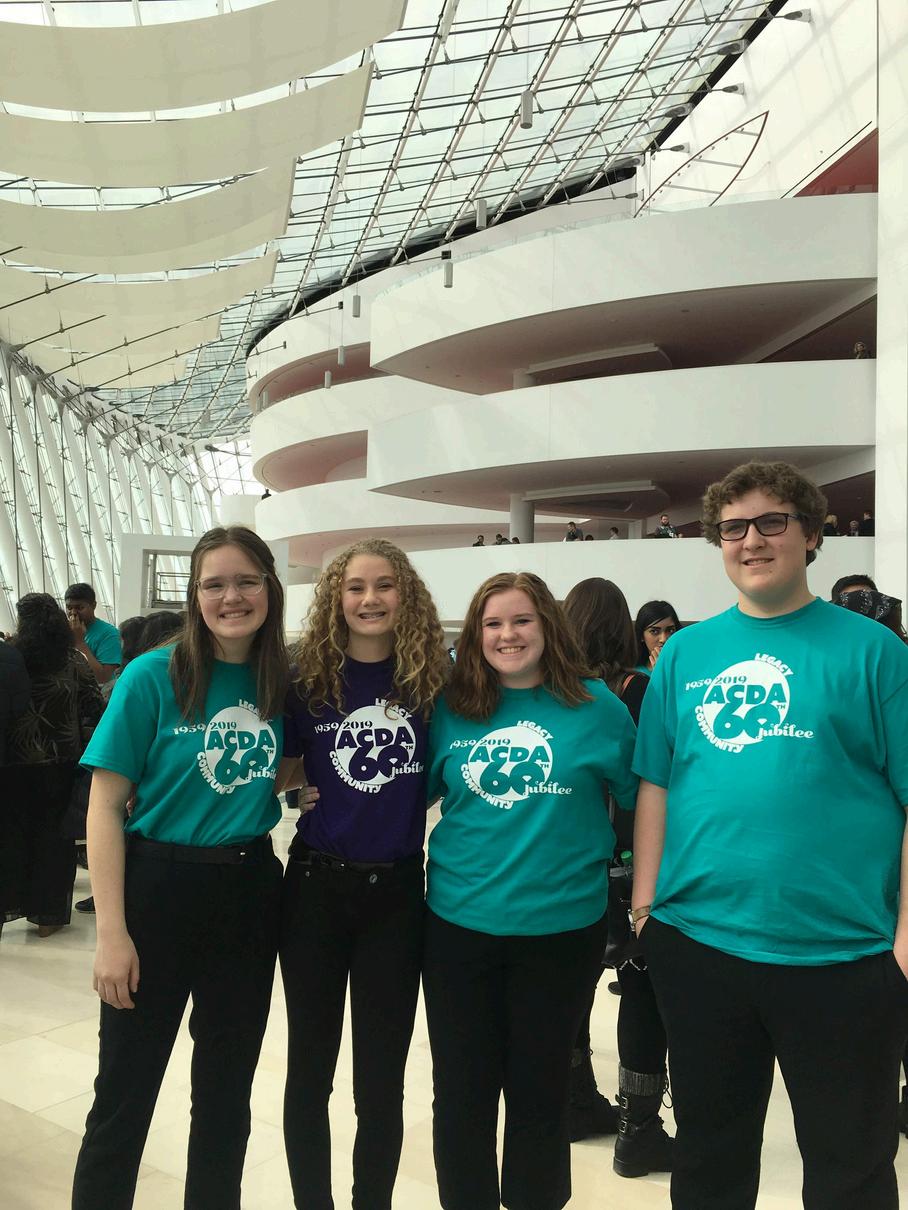
(R) 20 CHOIR
Would you recommend it? What kind of child do you think would like this experience?
Yes, definitely, absolutely! I think the kind of child that would like this experience would be one who likes to sing and wants to learn different kinds of music. - Amber R.

A child who loves to sing. Like, who really, really loves to sing. Who feels the music and enjoys a challenge and comes alive when the harmonies and the melodies come together in a powerful sound Being in Honor Choir opens the door to different teaching methods and people, and they stick with you for years after - Brisbynne A


I think it’s beneficial for all kids who love choir. I would say you ’ ve got to REALLY love choir because we were singing all day, but I loved it. I would’ve gone to more rehearsals if we had them! You learn so much, not just about music, but about independence, compassion, and community - Isabel G
For sure Definitely meeting a bunch of new people was intimidating to me as a kid Also, performing at the big venues - I remember in Salt Lake City we performed at Abravanel Hall, and that was a long time ago, but I still remember the name of the performance place. We performed at some BIG venues with huge audiences. I still remember my seat at each of those places. It was a lot of pressure! We had worked so hard and we had this performance at the end and you feel like it has to be good I remember feeling like no one can mess up, because there were so many of us! - Ivy S
Was it fun to meet people who liked singing too?
Yes, I had something in common with them and it made it easier to become their friend. - Amber R
Yes!! It was super fun to talk to the kids that sat around me and hear cool stories about where they were from! We all bonded over being big choir nerds! - Brisbynne A
It was really great to meet other people. As a kid, it was always so cool to hear what states other people were from. It was always great how you could live across the country but still have some of the same favorite choral pieces as one another. It’s an amazing experience to share with one another - Isabel G
Yes There’s one girl that I still keep in contact with from 2019 KC Ora and Ivy, we both had three letters in our names and we thought it was funny We sat next to each other and she was from Montana. What united us was our love for singing. Inside of all of us was the same person - someone who loved to sing. - Ivy S.
Was there anything scary/ intimidating about it?
Yes, I was scared that I was going to mess up the notes and scared to meet new people but we practiced so much that I did not mess up and I ended up making friends - Amber R
The first day was the most intimidating for sure There’s a pressure that you put on yourself at the beginning to be your very best and to not make a single mistake Once you relax and get more comfortable later into the rehearsals, you lose the feeling of being absolutely perfect and learn to enjoy the music! - Brisbynne A.
There were definitely moments that were intimidating for an 11 year old. There were all these rules like if you don’t have your music memorized or if you showed up late, you could be kicked out, so that seemed intimidating But in reality they didn’t want to kick anyone out, they wanted to make sure everyone felt confident in their performance and for the rehearsals go smoothly without interruptions. Overall it was a very positive environment. - Isabel G.
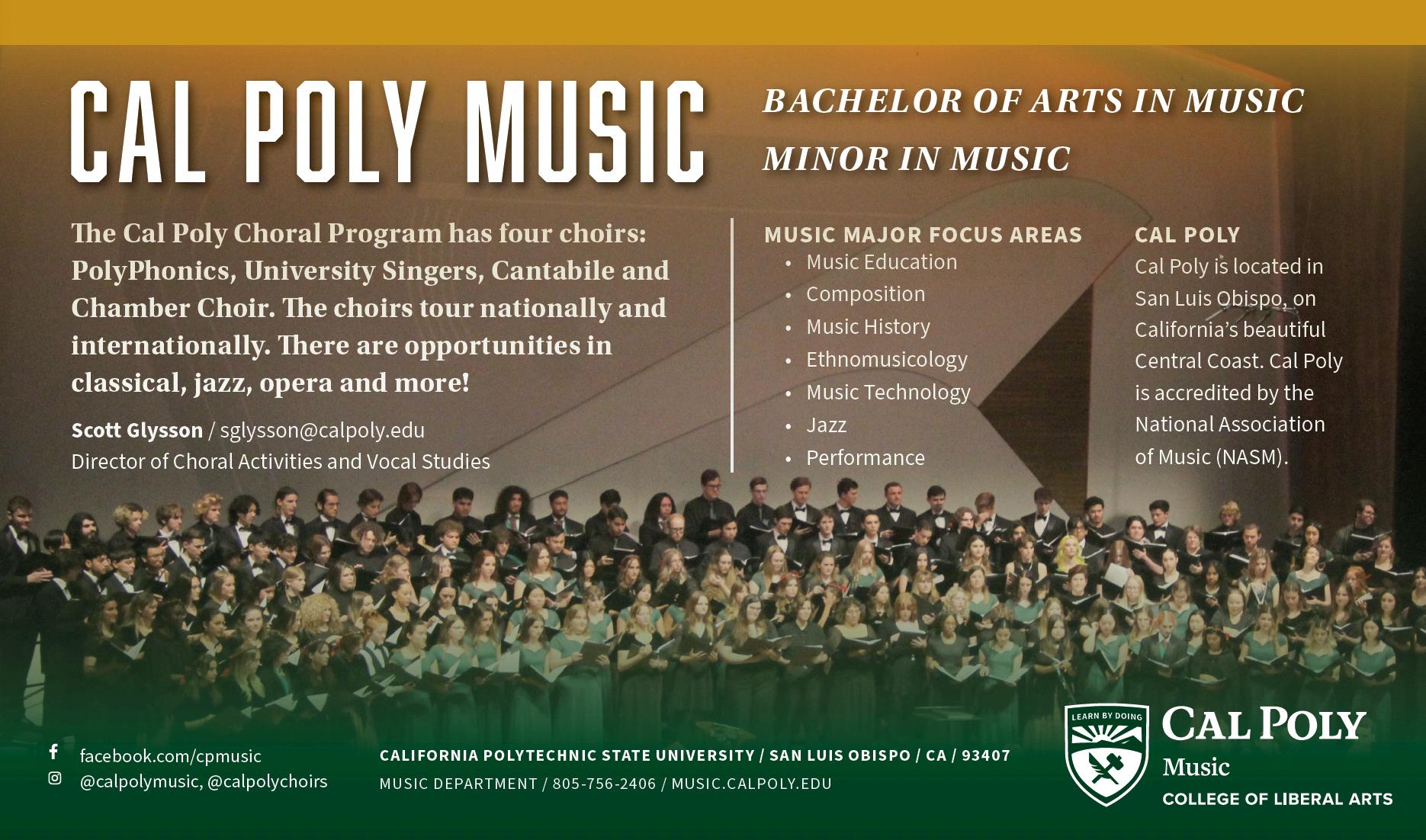
BY MARCELA MOLINA
This past fall, our now president, Julie Dana, called me with an opportunity. She shared her dreams and her vision for the future of WACDA. I was drawn by her passion for the unseen, overlooked, and untapped. Growing up in Bogotá, Colombia, organizations like ACDA and its resources were/are scarce The opportunities provided to me in this amazing country have propelled me to a miraculous career of possibilities. It took Julie about five minutes before I wanted to say: "You can stop now, I am in!"
My name is Marcela Molina, and I serve as Youth R&R coordinator. When I started as Artistic Director of the Tucson Girls Chorus (TGC), I was an ABD candidate doctoral student at the University of Arizona. I was knowledgeable about the history of motets and madrigals, but very little about building a communitybased organization Fast-forward 17 years, I am grateful for the many failures, questioning, and deep relationships I have built throughout my tenure as both Executive and Artistic Director of the TGC and most recently as director of the Tucson Symphony Orchestra Chorus If I had to summarize my biggest lesson, I would say it's the power of intentional listening
As musicians, we work on developing our ears, but are we really trained to listen or be curious? Listening is active and purposeful, requiring attention and observation Curiosity is a powerful driving force that propels us to explore, discover, and learn It's the innate desire to know more, to understand the unknown, and to seek out the unfamiliar even if it makes us uncomfortable. Curiosity fuels innovation, creativity, and progress by pushing us to ask questions, challenge assumptions, and think beyond the conventional
The interaction between listening and curiosity is a dynamic and powerful force that evolves into deep partnerships and connections with people. Curiosity drives individuals to seek new knowledge and explore uncharted territories, often resulting in partnerships that leverage the combined strengths and resources of different entities to achieve common goals. This is ACDA Western Division. I am surrounded by a group of committed leaders from across the region leading with me who are curious and ready to explore We are eager to listen, to learn, and to discover I can’t wait to get to know as many of you as possible so we can dream and build together.
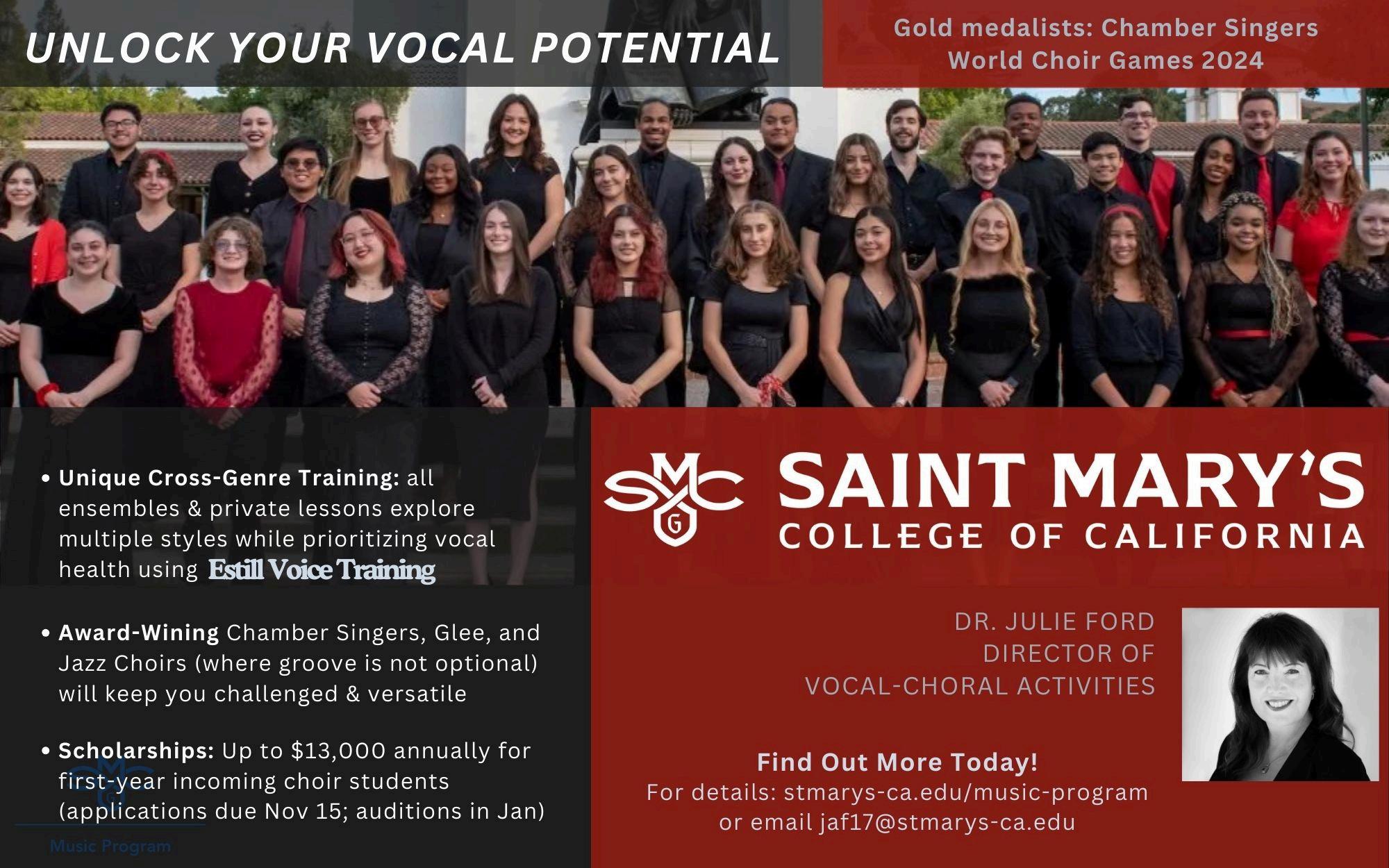
BY JOANNA HABERMANN & JENNIFER LOWRY
These tried and true selections work so well for young singers that they may become standbys in your annual programming, if they aren’t already!
J'entends Le Moulin
arr. Emily Crocker
Two part, SAB or SA(T)B
Hear the steady sound of the mill wheel in this brisk setting of the French Canadian folk song, which uses alternate French and English text. "I hear the windmill, tick-a tick-a tack-a " Use the pronunciation guide on the inside cover or the Teaching P/A CD to practice the French lyrics This is easy and fun to sing!
Festival Sanctus
John Leavitt
multiple voicings
A long-time favorite on the festival circuit, this dynamic, exciting, joyous selection surpasses the ordinary! Syncopated rhythms and changing meters, combined with a sizzling piano part, make this a uniquely rewarding work Very accessible for school and church choirs, it is a first-rate choice for any performance situation!
Do Not Stand at My Grave and Weep
Laura Farnell
SATB or SSA
This is a piece with beautiful lines where each voice gets to shine at different times throughout Optional C instrument/violin adds so much dimension
Non, Nobis Domine
William Byrd, arr. Bartle
SSA
Teach the whole choir each line; this is just a canon! It’s great for practicing pure vowels and sustained phrases The alto line works for some early cambiata voices The S1 & S2 lines could be doubled down the octave if you have strong trebles but only a few changed voices
Night of Silence
Daniel Kantor, arr Ferguson unison partner song with “Silent Night”
There’s nothing better at Christmastime than “Silent Night,” and “Night of Silence” is still its best partner song. If your students study different foreign languages, try featuring groups of students singing “Silent Night” in each of the languages they are learning Alternate or layer verses of “Night of Silence” and you ’ ve got an easy and gorgeous medley
The Sleigh Richard Kountz, arr Riegger many voicings
This song is classic fun from 1926, yet it still feels fresh. Make the A phrases light and staccato and contrast them with legato B phrases for a dramatic lesson in articulation. Take the tempo as fast as you can manage and have fun feeling the winter wind as you bounce along in the sleigh This song sounds much harder than it really is, but it does require a good accompanist
Windy Nights
Cynthia Gray 3pt mixed, 2- or 3-pt or SSA
A dramatic poem by Robert Louis Stevenson is the inspiration for this intense, exhilarating work, which portrays the poet's childhood fear of storms The music aptly captures the sound and excitement of a stormy, windy night, which the text likens to a riding horseman and the pounding of his horse's hooves Excellent editorial notes provide fascinating background about this poem and its famous author. This is wonderful poetry and accessible music for developing choirs!
Wicked Choral Medley
Stephen Schwartz, arr Huff 2-pt and 3-pt mixed
Wicked Choral Highlights
Stephen Schwartz, arr. Brymer SSA, SAB & SATB
Wicked, the movie, opens in theaters in November, 2024! “It’s time to try defying gravity!”
Swinging on a Star
Jimmy Van Heusen, arr. Gilpin 2pt, SSA, 3-pt mixed
Your choir will have a lot of fun with this humorous pop novelty hit from the '40s This arrangement has a relaxed swing feel, a hint of jazz harmonies, and crazy lyrics that make it an ideal lighter selection or show choir feature! Choreography suggestions are included.
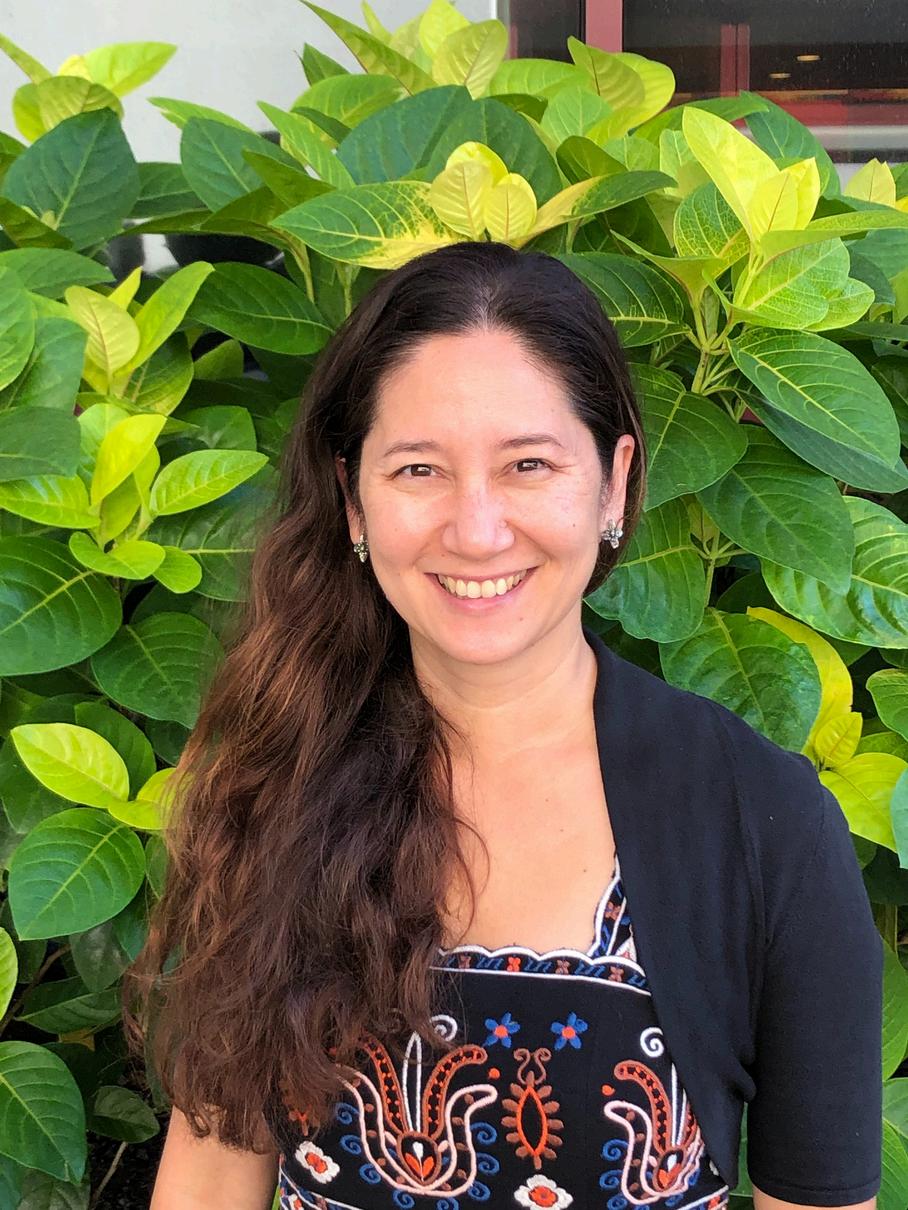
Joanna Takagi Habermann teaches Middle School Choir and Music at Punahou School and directs the Cantilena ensemble of the Hawaiʻi Youth Opera Chorus. Joanna’s breadth of experience includes teaching choir and general music at K-12 schools in Hawaiʻi, California, Florida, Texas and Indiana, working as a Kindermusik® and early childhood music educator, and directing adult ensembles in a variety of settings. She holds a BA in Music from Pomona College, a MM in Choral Conducting from Butler University, and a Kodály Certificate from Texas State University. Joanna lives in Honolulu with her husband Josh, who is also a choral musician, and their two children
Jennifer Lowry is a choir director in the Clark County School District. She has taught middle school choir for 17 years, 14 of which have been at Del Webb Middle School She holds a BME from Western Washington University She is honored to serve as the Nevada ACDA President. Mrs. Lowry’s choirs have performed at Regional and National
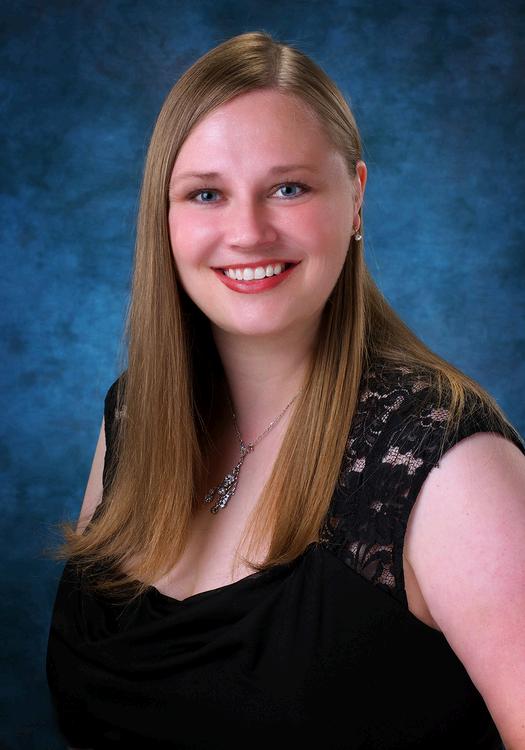
ACDA Conferences (2014, 2019). She is committed to helping her students learn to express their emotions through music in a safe environment. She lives in Henderson, NV with her husband, daughter, and dog

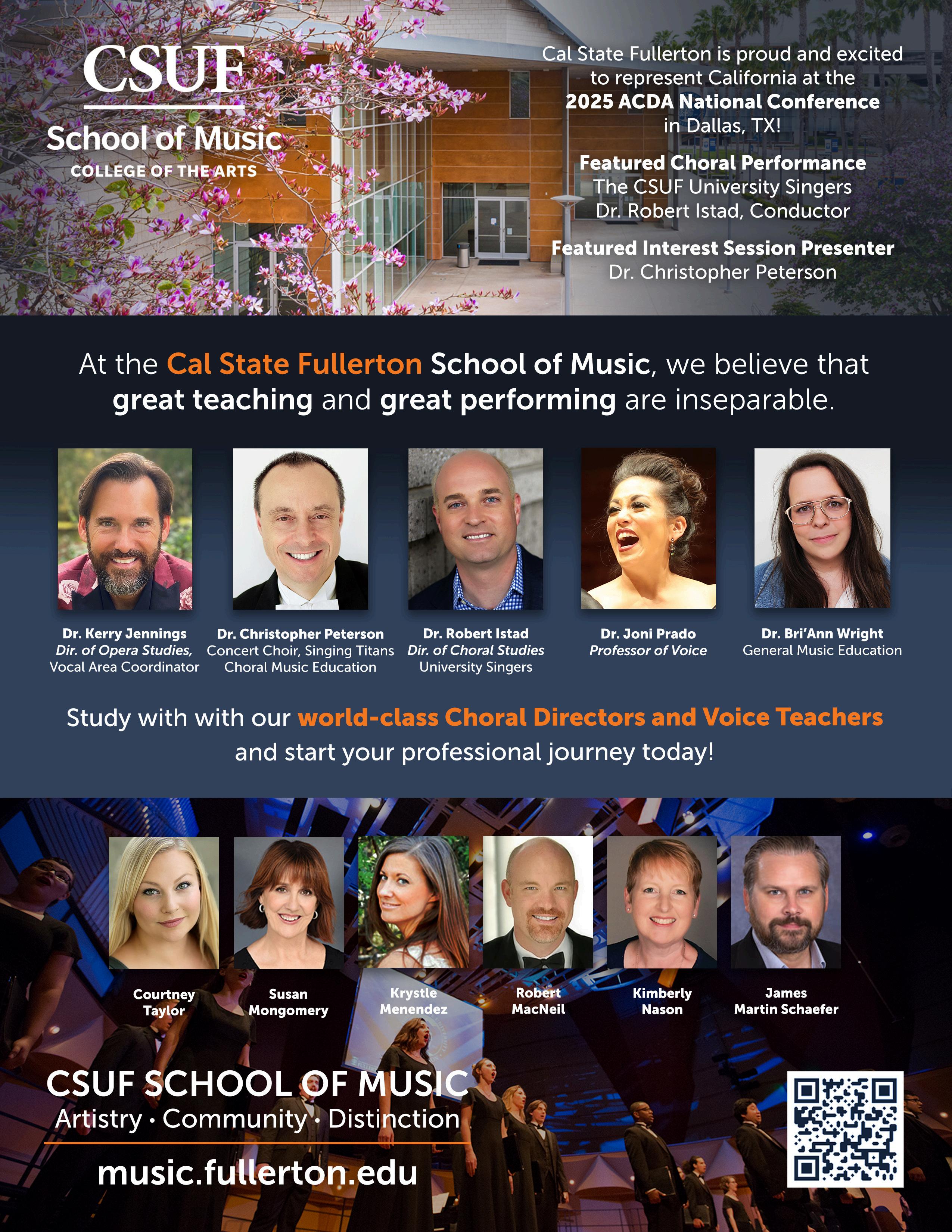

Easy Two-Part and Unison
A Shaker Celebration
arr. Becky Slagle Mayo
BY LESLIE WALKER AND LEANNA CROCKETT
This lovely piece weaves three Shaker tunes together: Hop Up and Jump Up, Love is Little and Simple Gifts
We love to use this as a contrasting piece to some of our more lively tunes.
Blue Waters of the North Two or Three Equal Parts
arr. Phyllis Wolfe
A piece so catchy, you’ll find yourself singing it while paddling down a river in your own canoe! Easily accessible to younger choirs and a lot of fun!
Hand Me Down My Silver Trumpet
arr Jean Ashworth Bartle
Piece is unison until the chorus, where the altos drop down with a fun echo and easy harmony Jabberwocky
by Carolyn Jennings
Anton Armstrong introduced us to this piece at a festival in SLC. It has become a favorite that the children beg for. It ends up in a three part partner song at the conclusion that is easily doable by an intermediate choir
Let Me Fly (Traditional Spiritual)
arr. Rollo Dilworth
Dillworth is at his best for children with his awesome version of Let Me Fly It’s simple, yet challenging, and kids love it!
Wind on the Hill
arr Victoria Ebel-Sabo
This captivating melody engages the listener and singer
We love to use scarves in our rehearsals of this because of its floaty quality. It is unison with piano and recorder (or flute).
Soprano-Alto
Answer to a Child’s Question
arr. Timothy Strang
One of our former children’s choir singers who became a HS director loved this so much, he programmed it for his choir! This has a beautiful melody and lovely harmony in the chorus
Music in My Mother’s House
SSAA
arr J David Moore
This arrangement by David Moore is a bit difficult, but so worth the effort! We love seeing the looks on our singers' faces as they sing to their parents. It’s heartfelt and fun at the same time.
Shojojee (Japanese Folk Song)
arr. B. Wayne Bisbee
The Japanese is easy to tackle and has such a fun accompaniment.
The Drinking Gourd
arr. Andre J. Thomas
We love this piece because of its history and message, and because it’s so fun to sing and extremely satisfying to perform
Tum Balalayka (Russian Yiddish Folk Song) SSA
arr Marjan Helms
Performed in Yiddish with a counter melody that represents the sound the balalyka makes. In three parts, this is more difficult, but doable, especially at the end of the year when the choir has had more experience.
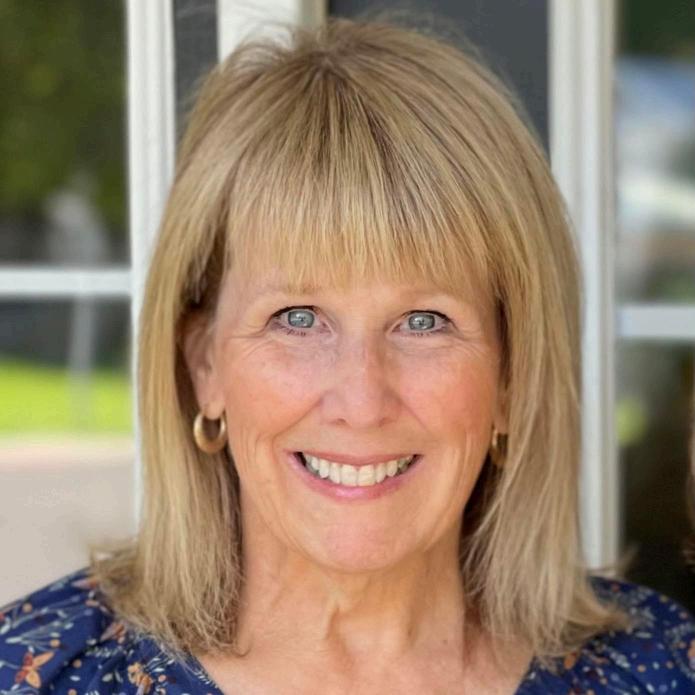
Leslie Walker has organized and directed children’s choirs for the past forty years She and her friend, Leanna Crockett direct Hobble Creek Singers Children’s Choir in Springville, Utah. Leslie earned a master’s degree in vocal performance and pedagogy from BYU. She currently serves as the Children and Youth Community R&R Chair for the ACDA Western Division. Leslie recently retired from directing choral activities at Springville High School Prior to that, she conducted the choirs at Springville Junior High and was a vocal instructor She and her husband, Mark, have five children and thirteen grandchildren.
BY LAURIE HANCOCK
I’d like to introduce myself as your new Western Region Membership Chair. I’m a retired middle school and K-6 music educator and I’m excited to start this new position Your input is valuable to me and I hope to receive some ideas from you about how our region (Hawaii, California, Utah, Arizona and Nevada) can attract more members
My undergraduate experiences at CSULB gave me a great opinion of ACDA; I was eager to join and become a part of this choral community. However, I know this is not the case for everyone, and I would love to understand what may be keeping people from joining ACDA I don’t consider myself to be much of a “joiner” but I never considered NOT being a part of ACDA Obviously everyone who is receiving this article is already an ACDA member so in a sense this is “preaching to the choir,” but maybe you can come up with some ideas for me regardless.
Some things I have been considering are:
Intimidated by more experienced teachers and conductors? (This was me for a LONG time, but I had already joined so it was too late )
Cost?
Relevance?
Concern about being asked to do stuff?
Lack of experience with ACDA?
Forgot to renew and just let it slide?
Bad experience with other professional organizations?
One thing I think we can all do is reach out to our friends and colleagues, at the very least making sure they know about ACDA and what a great resource it is Maybe ask them if they have joined, and, if they haven’t, find out why (and then let me know!).
Thanks in advance!
With joy and great expectations,
Laurie Hancock
Western Region Membership Chair lahmusic@icloud com
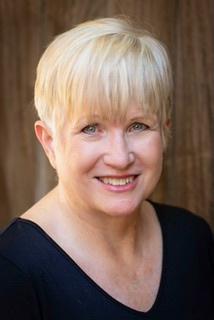
Laurie Hancock received her B.M. degree in Choral/Vocal Studies from California State University, Long Beach She taught middle school choir at Ladera Vista Junior High in Fullerton where she was named Teacher of the Year in 2005 During this time she served as Jr. High Festival Coordinator, Southern California Vocal Association. After relocating to Washington State, she continued teaching middle school choir and elementary general music in Fall City, WA., in addition to directing the Snoqualmie Valley Girls Chorus for two seasons Before retiring in 2020, Mrs Hancock taught private voice lessons, and worked in community youth musical theater productions She and her husband now live in Mission Viejo, California and enjoy travel, their church, the Dodgers and their two grandsons. She is looking forward to serving as Membership Co-Chair and connecting with the choral community again.

BY CHRISTINA HALL
Attending ACDA conferences is a wonderful opportunity for choral directors looking to rejuvenate their skills, network with other directors, and inspire their students However, financial concerns can sometimes be a barrier Fortunately, federally and state-funded choral directors have access to Title II professional development funds, which can significantly ease the cost of attending these valuable events. This article provides a comprehensive guide on how to access and utilize these funds for your next conference.
Title II funds are designated for professional development, allowing educators to enhance their skills and knowledge The allocation and utilization of these funds can vary from state to state, covering expenses such as conference registration, transportation, lodging, and meals Here’s how you can tap into these resources effectively:
1. Do Your Research
Before applying for funding, gather detailed information about your conference trip:
Registration Fees: Find out the total cost for attending the conference
Transportation: Decide on your mode of travel whether it's by airplane, district vehicle, or private vehicle. If you ' re traveling out-of-state, you may need to provide multiple quotes for approval.
Lodging: Determine where you’ll stay, either at the recommended conference hotel or another approved location Note that accommodations like Airbnb are generally not covered
Meals: Calculate the number of days you’ll need meals. Different days have varying reimbursement rates: Initial day, full day, and final day. Each state may have specific rules on meal reimbursement timing.
Important: Collect estimates for each of these expenses, either as screenshots or PDFs, to support your purchase order requests Ensure you have all necessary forms completed and submitted well in advance, as processing can take several months
Fill out a purchase order (PO) for each expense category (or how you request funds in your district). Here’s what to include:
Conference Registration: Specify the registration cost and include any required documentation.
Transportation: Detail your travel arrangements and associated costs
Lodging: List your accommodation expenses and include booking information.
Incidental Reimbursements: Include costs for meals, airport parking, and ground transportation, if necessary. Ride-sharing apps may work (Uber, Lyft, etc ), so take a screenshot of a sample ride and you may be reimbursed for that amount
For each PO, attach the estimated quotes and ensure you use the correct wording based on your state’s guidelines For example:
Arizona: “Aligns with ADOA – GAO practices” California: “In accordance with CalHR policy” Submit each PO with its corresponding quotes to the relevant department.
While traveling, keep all original receipts related to your conference expenses, including boarding passes, lodging receipts, and any other incidental costs Organize these receipts by category in envelopes or a folder to simplify the reimbursement process. Upon returning, submit all receipts to your district for reimbursement. Some districts may cover transportation and lodging expenses upfront, so be sure to provide those receipts for record keeping as well.
**Districts vary in who to contact and the timing of your conference funding request, so my recommendation is to gather quotes and submit no later than December Title II funding is only available until it runs out and is generally on a first-come first-serve basis.
Each state in the Western Region has its own process and reimbursement rates. Here are useful links for checking federal per diem rates and specific state guidelines:
Federal Per Diem Rate Information: https://www.gsa.gov/travel/plan-book/per-diem-rates
Arizona
Scroll down to “Travel” for detailed information
Hawai‘i
Look under the category “Travel ”
Title II funding regulations can change yearly, so be sure to check each year for updates in your state. By following these steps and utilizing Title II funding, you can make the most of your professional development opportunities and bring renewed energy and expertise to your choral program
As modeling is a great tool we use for our students daily, here is a link to a sample Title II funding request from Arizona:
California
Refer to the state’s travel policies
Nevada & Utah Consult federal guidelines for travel
For those wishing to attend the national ACDA Conference in Dallas March 18-22, 2025, scan the QR code for sample reimbursement rates. Registration opens Fall 2024.

Federal Per Diem Rate Information
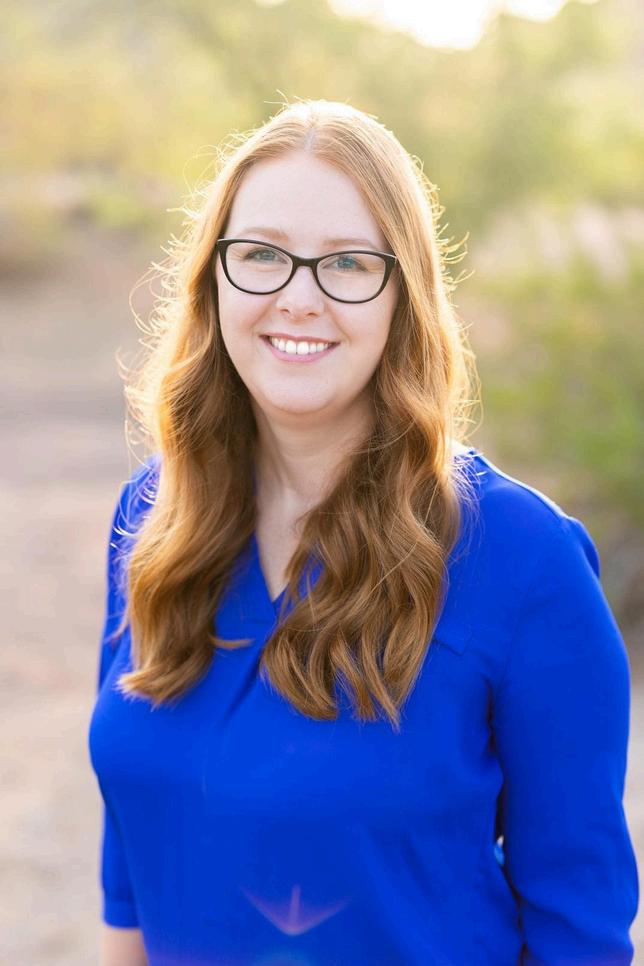
Christina Hall, Director of Music Ministries at Living Water Lutheran Church in North Scottsdale, is currently pursuing her MM in Choral Conducting at Arizona State University. Previously, she served as choir director at Millennium High School in Goodyear, Arizona, where she directed choir, class guitar, and established the district's first piano curriculum. She holds a Bachelor of Arts in Choral Music Education from Northern Arizona University, studying under Dr. Edith Copley Christina serves her second term as the Youth Repertoire & Resources Coordinator for ACDA Western Region and her first term as the Arizona ACDA Vocal Jazz Chair
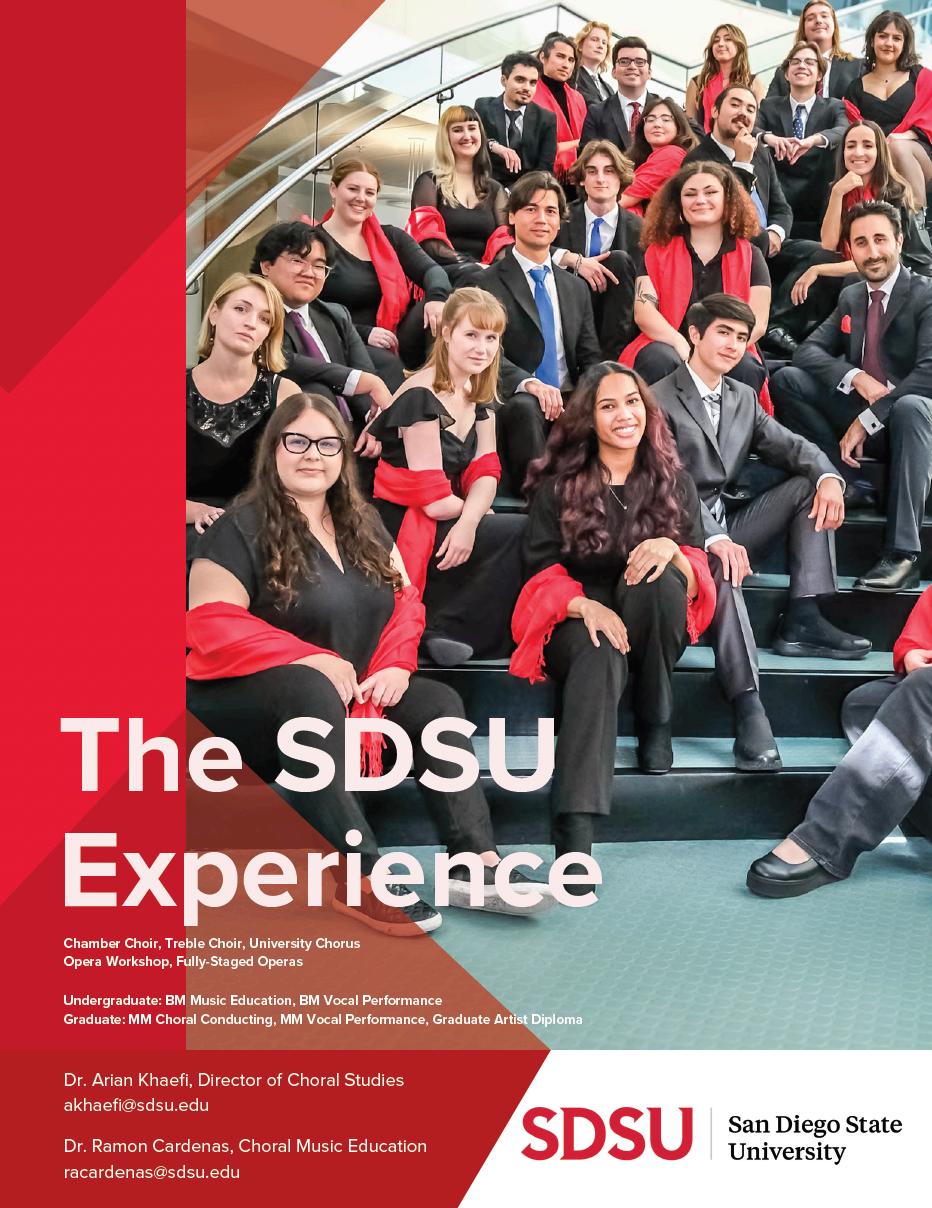
BY CYNTHIA SALOMONSON
At the beginning of the school year, we peruse and look for the perfect and best literature for our choirs. This process can feel overwhelming due to the amount of music available I have created a repertoire list of literature of tried-and-true standards, as well as newer octavos, that have worked well and have been successful for the fall semester The list includes songs for the beginning of the year or first semester festival or concerts. This list is just the tip of the iceberg!
Some of my favorite go-to composers that write wonderfully for elementary voices are Andrea Ramsey, Earlene Rentz, Amy Bernon, Audrey Snyder, Neil Ginsberg and Mary Lynn Lightfoot They compose songs with ranges that are suitable for the young voice that have enjoyable and engaging melodies for young singers, as well as harmonies that are achievable and allow students to feel successful.
Songs with movement and body percussion
JingleattheWindow
RuthE.Dwyer,ed. HenryLeck 3part
ShakethePapayaDown arr.RuthDwyerand JudithWaller 3part
YonderComeDay arr.JudithCookTucker 3part[addbody percussion]
Countermelodies2-part
Alleluia!IWillSing DavidWaggoner
CanoeSong arr.RuthMorrisGray
ISeetheMoon DouglasBeam
FestivalorConcert2-part
AllThingsBrightand Beautiful
PhilipE.Silvey
ClapYourHandsandSing!
MaryLynnLightfoot
DreamKeeper
RolloDilworth
FlyAwayHome
Pinkzebra
Fly,Fly,Fly
KelseyHohnstein-Reinhart
Grow,LittleTree
AndreaRamsey
LaLoo,LaLow
SandraHoward
OutintheFields
AndreaRamsey
Pasture
DanielKallman Unison
Sarasponda arr Ruth Boshkoff
Sing to Me
Andrea Ramsey
Some One Cristi Cary Miller
The Spider
Greg Gilpin
The Water Is Wide arr. Rollo Dilworth
Three Dominican Folksongs arr. Francisco J. Nunez
Tres Canciones de Los Elementos (Three Songs About the Elements)
Victor C. Johnson
Wangolo arr. Ruth Morris Gray
Winter2-part
CoorooCooroo
SteveKupferschmid
InWinter VictorC.Johnson
SnowSong ChristinaWhittenThomas
StoppingbyWoodsona SnowyEvening AudreySnyder
TheWonderoftheSnow EarleneRentz
WhenSweetWinter ComesAgain CynthiaGray
Winter's Waking
Amy F Bernon
Winterlight
Amy F Bernon
Wintersong
Audrey Snyder 2/3 part
Wintersong
Audrey Snyder 2/3 part
With the Earth, I Am One Judith Herrington
Christmas
CaroloftheAngels JillGallina 2part
CuckooFlewOutoftheWoodsSlovakCarol
arr.B.WayneBisbee Unison
DormiDormi arr.Goetze Unison
LullayAlleluia
RuthElaineSchram 2part
OnThisStill,SilentNight arr.LauraFarnell 2part
Continued Elementary R&R Easy Fall List
The use of folksongs, partner songs, singing games, warm-ups, and activities are fun ways to achieve successful part singing, as well as great resources for vocal development and active listening A sequence of songs to teach part singing that is successful with younger singers is: unison, ostinato (rhythmic and melodic), descants, canon, partner songs, easy two-part harmony. There are many books available for voice building, canons and part singing, and listed are just a few
Quick Starts for Young Choirs-Activities and Ideas to Focus Your Singers by Cristi Cary Miller and Angela K. McKenna
Harmony Handbook ed. Katie O'Connor-Ballantyne
Counterpoint (Partner Songs and Canons for Singers of Any Age) by Anna Wentlent
Where in the World (Folksong Warmups from Many Lands) by Helen Kemp
Warming Up with Rounds (Teaching Music Literacy Using Rounds in the Classroom) by Catherine Delanoy
Vocalize! and Vocalize! 2 (36 More Accompanied Exercises that Teach Technique) by Andy Beck
Choir Builders: Fundamental Vocal Techniques for Classroom and General Use by Rollo Dilworth
As you start your vocal development at the beginning of the year, remember time management and pacing! Plan and vary activities and literature throughout rehearsals including engaging breathing activities; tone development through voice building exercises; ear training and sight reading; activities and harmonies using ostinatos, canons and partner songs; listening activities and audiation; brain breaks; movement; and literature for up to 10-12 minutes each song
I hope this helps you as you jump into the start of the 2024-25 school year, and may it be a successful and exciting one for you! Feel free to reach out if you have any questions. (cynthiasalomonson@cusd.com)
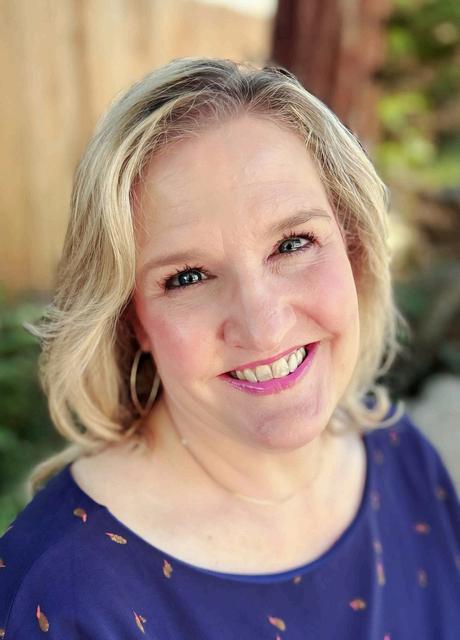
Cynthia Salomonson has taught music in public schools and private organizations throughout California’s Central Valley for 32 years. She is currently an elementary music specialist with Clovis Unified School District and serves as one of the VAPA Elementary Choral and Classroom Music Resource Teachers. Previously, she was the Associate Director and later the Artistic Director of both the Central California Children’s Choir and Bach Children’s Choir spanning 22 years
Cynthia’s formal education includes a Bachelor of Arts in Music from California State University, Fresno in vocal performance with an emphasis in choral conducting, where she studied voice with Helene Joseph-Weil and conducting with Dr Gary Unruh Cynthia loves making music with young musicians and desires to instill in them a joy and passion for music and the arts
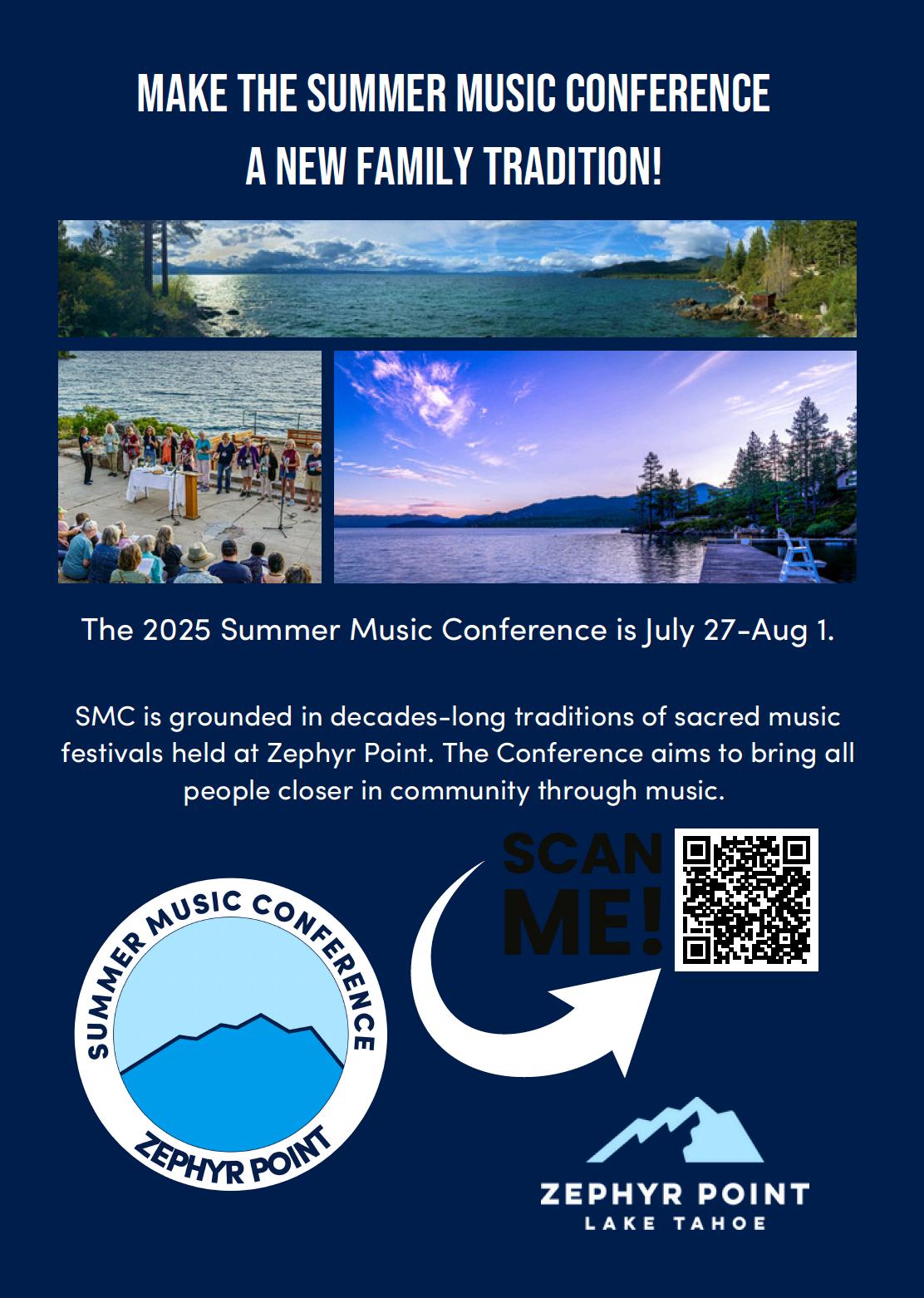
BY HANNAH KIMBALL
In today's rapidly evolving educational and technological landscape, artificial intelligence (AI) is emerging as a powerful ally for all professionals, including music educators. From crafting engaging lesson plans and parent communications to generating visual aids and even composing music, AI opens up new possibilities for choir directors to work more efficiently and focus on what truly matters: inspiring and nurturing young musicians In this article, I will provide a multitude of resources and specific prompts to assist choral music educators in beginning to explore the use of AI in their work.
Absolutely There are numerous tools available, with more continually being created, that can make our lives easier and help us focus on the most important part of our jobs our singers and the music we make with them. As music educators, we face endless expectations and responsibilities, and burnout is increasingly common in our field We must take care of ourselves and use every tool available to lighten our load
Yes, but there are some important considerations:
- AI is not yet a fully reliable source for research Always double-check facts and sources before passing off information to students
- Not all AI tools are “school appropriate.” Ensure you have vetted any tool before setting your students to work with it.
- Never include real student names or any protected information when using AI tools, as these tools are learning from what you input It is possible that any information you provide could become searchable later on
- Stay aware of copyright information when utilizing AI with existing lyrics, songs, arrangements, etc
- It may go without saying, but I encourage individuals to do their own research and engage in discourse about this topic. I am not an expert. My qualifications come from the past year of learning about AI through my own research and trial and error. I don’t personally have all the answers But it is a fascinating and constantly changing field It is worth discussing as the technology continues to grow, improve, and adapt
Now that we ’ ve addressed some of the important questions, here are some practical ways to utilize AI: writing help, lesson plans, creating quick and attractive presentations and other handouts/visuals, simple assessments, creating backing tracks, composing music, and much more Read on to explore more specifics of each of these topics
There is an abundance of text-based AI tools out there, or Natural Language Processing (NLP) tools NLPs are “ a branch of AI focused on enabling computers to understand, interpret, and generate human language in a way that is meaningful and contextually relevant ” Here are a few of my personal favorites:
- ChatGPT: This is the classic AI text generation tool, capable of producing human-like written content.
- Google Gemini: Google’s take on AI, which uses current Google search engine information to inform responses.
- Claude by Anthropic: This NLP’s specific power is that you can input photos or PDFs for the AI to analyze or read as part of your request
- Perplexity: This tool includes links to references to assist your research and for easy info verification
The power of the NLP is that you can use it to write any text in a matter of seconds. The more specific you can be with your prompt, the better. Here are some specific examples of prompts to input into any of these NLPs Copy and paste these prompts into the NLP of your choice and explore for yourself with different details (but remember not to include any specific student names or protected information):
- “Please compose an email to choir families informing them that there is a choir concert on May 1st at 7 pm. Include the following details: concert uniforms of choir dresses and tuxes are required, call time for students is 5:30 pm, concessions will be sold, tickets are $5, concert is located in the school auditorium And please write it in a playful and excited tone ”
- “Please write an email to a parent to tell them their child was being disruptive in choir class today Tell them the student was out of their seat, using disrespectful language, and was sent out of the classroom. Make it professional and grateful to the parent for their support ”
- “Please write a foreword for a concert program for a high school choir concert on the theme of ‘We Are One: Songs of Unity and Hope.’”
- “Please write a lesson plan for a beginning high school choir ensemble rehearsing measures 80-89 of ‘Go Tell it On the Mountain’ with emphasis on dynamic contrast and legato vs staccato phrasing ”
There are endless possibilities for utilizing these NLPs, including sub plans, bellwork questions, concert themes and pieces to fit within said themes, music history outlines/reading sources for students, song lyrics, solfege melodies for lyrics, and chord progressions for lyrics. If you don’t like what you receive on the first try, provide feedback like “make it more succinct” or “make the lesson plan more detailed with definitions of all the music terminology for the sub,” or “revise this to be at a 7th grade reading level ” The more specific the topic, the less likely AI is to know a lot about it, but it thinks it does. If it’s a topic you aren’t an expert in, consider using Perplexity so it is easier to verify the sources, or be sure to double-check the information yourself.
There are many different tools to help with graphic design A couple of great options are Gamma Slides and Canva (with Magic Studio). These tools can create actual content for your slides as well as design a visually pleasing presentation. The text generation ability is not as strong on these AI as the NLPs already discussed, but they can do the trick in a pinch. With Gamma, you can input a topic and it will create a whole presentation on the topic including visuals, and Canva can also do that Canva can create other graphics as well, such as social media posts or even concert programs However, you can expect to have to edit the content yourself after generating. Alternatively, use written content you already have or from an NLP to input into Gamma to create a presentation.
I would be remiss if I didn’t also mention the awesome power of AI to create photos Just try the following tools to create some cool pictures to include in your slides, handouts, etc: DALL-E (2 or 3), Midjourney, and Google Gemini
There are multiple ways to utilize AI to help create assessments. Makemusic.com (formerly SmartMusic) is the leading actual music assessment technology. Admittedly I have little experience with this software personally as it is a large classroom expense, but this software uses AI technology to grade musicians’ pitch and rhythmic accuracy on sight-reading exercises
Consider using the following prompts or similar in an NLP to generate questions:
- “Write 20 multiple-choice questions about the following text… (copy and paste text from a slideshow or a summary of a lesson).”
- “Write a handout for a high school choir class with 10 questions about… (insert topic here).”
You can also skip that step completely and use Questionwell - AI Question Generator to input a topic and create a self-grading computer-based assessment Questionwell will look at text you have imported (like content from a slideshow, a list of pre-made questions, research from an NLP, etc.) and convert it into a quiz in Google Forms, Quizziz, Kahoot, Canvas, Blooket, among many others. You can also use Chrome extensions such as Form Builder Plus to make lists of questions from an NLP into a Google Form. Think about the power that you have Combine this with Gamma Slides to make the easiest, fastest, self-grading sub plans ever, on any subject
There are a couple of ways to create backing tracks with AI First, there are a wide variety of musical AI tools that will remove vocals or “split” recordings into different “stems.” You can use these tools to create karaoke tracks from existing songs. The technology is not perfect, so I would recommend only using this in a pinch or in a rehearsal setting. (I also recommend researching the copyright information and getting permission where needed ) Two tools to remove vocals from existing recordings are LALAL.AI and Ultimate Vocal Remover There is also another way to scan or import PDFs of musical scores to create a MIDI file of the piece The app to accomplish this is called MusicScanner
In addition to using NLPs to compose simple music, there is different, more specifically musical technology as well. You can play around creating NLP music with prompts such as “Write a song about [any topic] and
include chords and solfege below the lyrics in the style of [any musician] ” Although the lyrics can be quite entertaining, the actual musicality tends to be limited when you try to play or sing these songs. Other more musically specific tools are:
- Scorecloud: A software that translates played or sung sounds into musical notation.
- Suno.ai: A tool where you can input a topic or a set of lyrics and a genre, and it will create an actual audio of a song with vocals and instrumental backgrounds
- Others like Suno include udio, Sonauto, and Boomy ***These AI may not filter out explicit lyrical content, use at your own risk!*
There are so many resources out there that not all of them could ever be listed in this article. But here are a few more to explore:
- What’s My Note: An app to help singers who don’t read music well find pitches on their sheet music.
- Eduaide: An all-in-one tool for teachers.
- MagicTools: Another all-in-one tool for teachers.
- Copilot: An AI combination NLP/photo generator by Microsoft
- Slides.ai: A tool for slide creation.
- Youtubetranscript.com: Creates text from YouTube videos, great for using with NLPs or to quickly check the validity of a source for students. (Be aware of copyrights)
- Semantic Scholar: AI that references scholarly journals
- Futuretools: A site to help you find the latest AI websites.
It is my hope that this article can help ease some anxiety surrounding the use of AI and encourage music educators to start exploring AI and how they can use it to their advantage. It is so important we stay aware of the technology, and the best way to do so is to be familiar with it ourselves I am not an expert, and there are certainly gaps in my knowledge on this subject All of my knowledge has come from my own personal research and trial and error Feel free to reach out if you have any questions or if you have found any amazing AI tools I missed. My email is hannah.kimball.teaches@gmail.com.
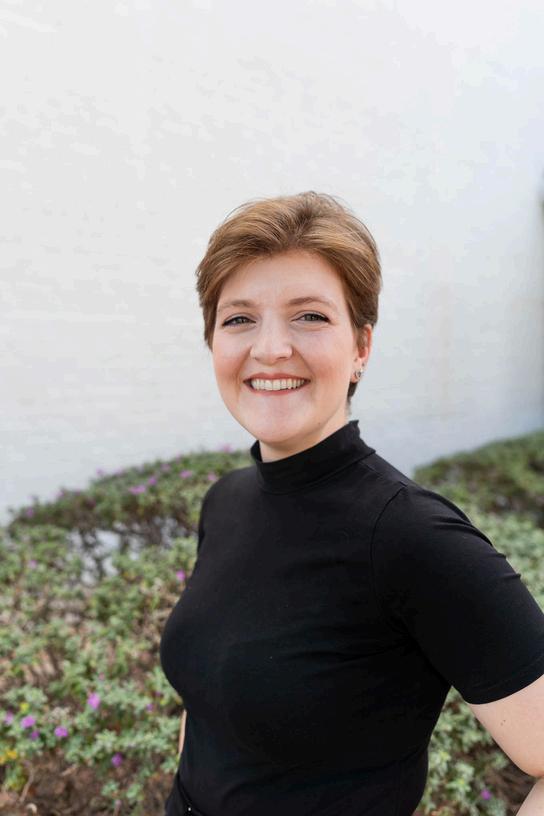
A graduate of Northern Arizona University, Hannah Olivia Kimball has over 5 years of teaching experience at the middle school level, having taught Chorus and Music Exploration at Kyrene MS, Pueblo MS, and Sossaman MS She also served as the Artistic Director of the Phoenix Women’s Chorus for two years, and sang with the Phoenix Chorale. Hannah will pursue a Master’s Degree in Choral Conducting at the University of Denver, serve as the Assistant Artistic Director of the Denver Women’s Chorus, and direct their small ensemble, Take Note!. Keeping so busy has led her to find new ways to manage and be as efficient with her time as possible, leading her into the discovery of AI and its many uses in our field! In her new-found free time, she enjoys roller-blading and crafting
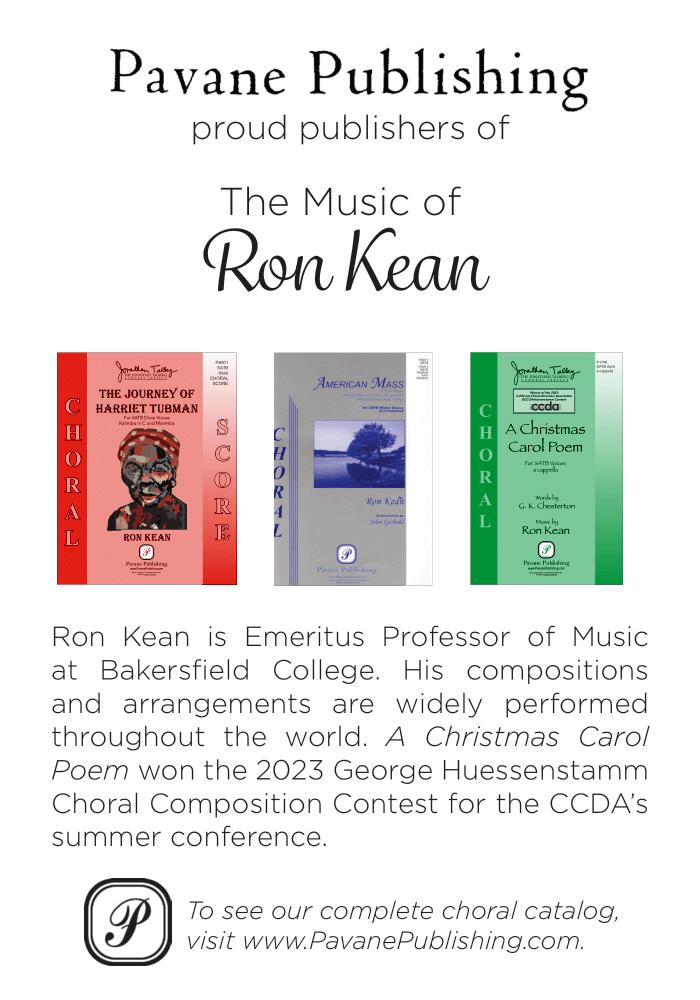
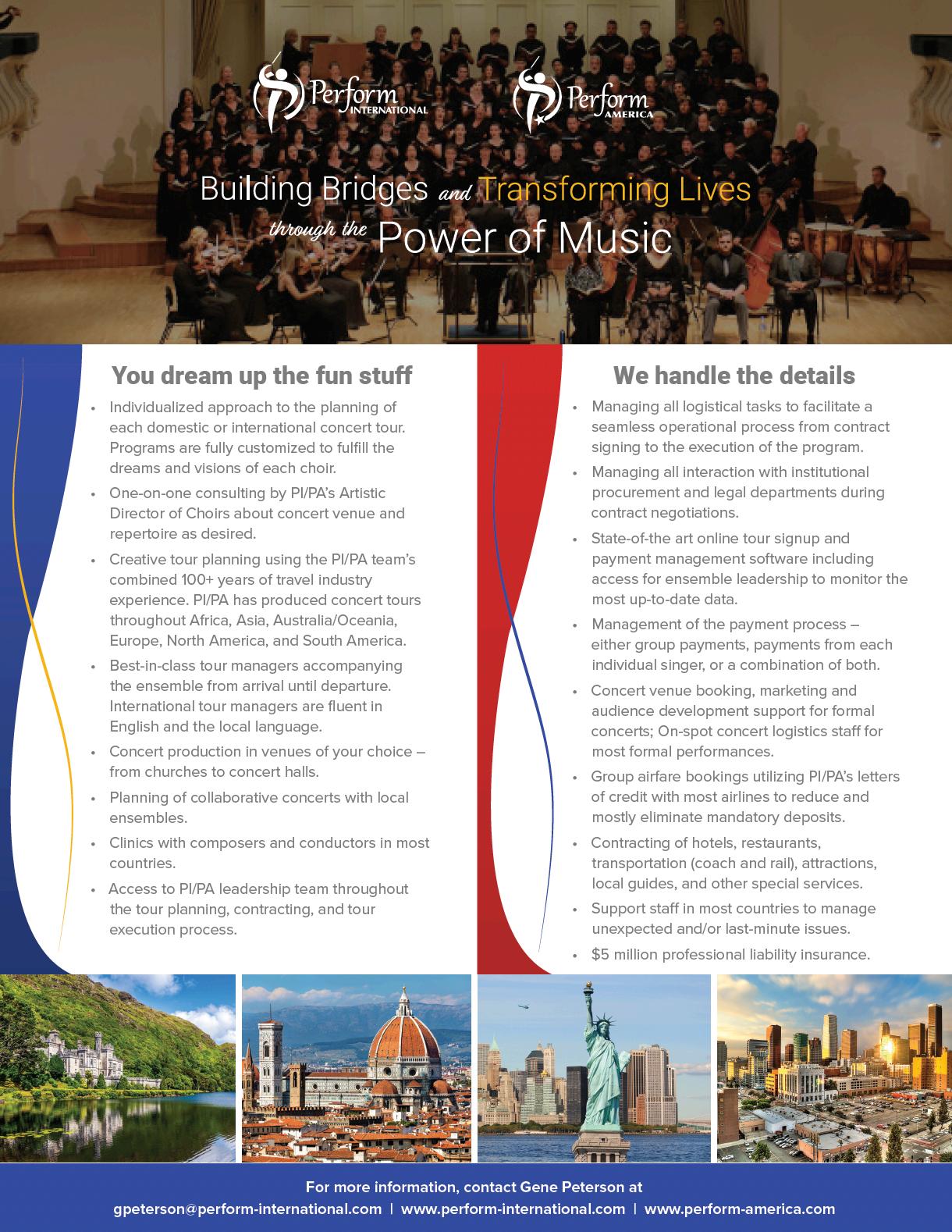
Greetings, Western ACDA!
BY STEPHANIE COUNCIL
I am honored to begin serving this region as your College and University Repertoire and Resources Coordinator. Since joining ACDA as a university student in 2003, I have benefitted immensely from all the organization has to offer Through the years I’ve read countless Choral Journal articles and connected with members of our organization about programming and other important topics through various ACDA Facebook groups. I’ve attended as many conferences as possible where I participated in the graduate student conducting competition, conducted reading sessions, gave presentations, sang in choirs, and heard life-changing performances by some of the best choirs in the world. Serving in leadership roles has given me the opportunity to see close-up the brilliance of our colleagues and develop meaningful connections and friendships It is hard to overstate the importance of ACDA in my professional life, and I know that is true for so many of us. The opportunities for growth and connection this organization provides leave me feeling inspired by our amazing artform and the incredible humans that make up ACDA.
In this coordinator role my immediate goals are to assist in fostering connections between college and university directors in our region, facilitate programming discussions and other enrichment opportunities relevant to our area in between conferences, encourage active participation from our college and university student members, and to be a resource for the Western ACDA membership in any way I can.
The other members of the College and University Repertoire and Resources team are Dr. Aaron Humble (4 Year College/University Chair), Dr Michael Huff (2 Year College Chair), and Dr Rachel Samet (Youth and Student Chair)
Please reach out to introduce yourself, say hello, and share any ideas or needs you may have with me. I’m curious to hear what you love about ACDA and how you’d like to see us continue to grow and improve. It is such a privilege and joy to serve you. Best wishes to you all for a wonderful new school year!
Stephanie Council: scouncil@acdawestern org
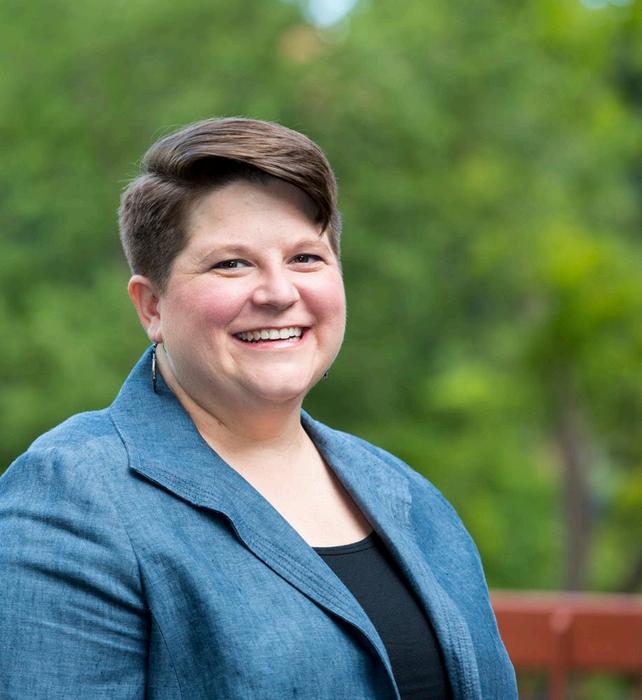
Conductor, educator, and singer Dr. Stephanie Council is Associate Director of Choral Studies at the University of Nevada, Las Vegas where she conducts the University Chorale, Chamber Choir, and Argenta (the treble voice ensemble) She maintains a private conducting studio of graduates and undergraduates, and teaches Advanced Choral Conducting, Choral Literature, and Choral Methods.
Dr Council is the founder and artistic director of Desert Singers Las Vegas, a professional-caliber women ’ s choral ensemble with the heart and dedication of an amateur chorus, and she sings professionally with mirabai, a professional women ’ s ensemble conducted by Dr. Sandra Snow, and the San Antonio Chamber Choir, a professional chamber choir conducted by Richard Bjella.
Sought-after as lecturer in choral music education and conductor of collegiate, high school, and youth choirs, Council has conducted clinics and honor choirs in Oklahoma, Texas, Massachusetts, New Hampshire, Vermont, Iowa, Nevada, Michigan, and in various European locations
Council earned the Doctor of Musical Arts degree in choral conducting and a graduate certificate in early music performance practice from Texas Tech University. She holds a Master of Music with distinction in choral conducting from Westminster Choir College and Bachelor of Music degrees in music education and vocal music performance from Oklahoma State University
BY AARON HUMBLE
In my years working in university choral programs, I’ve always approached programming concerts with a combination of excitement and trepidation. Will I have the right voices this year? Will the students connect to the music? But I’ve also observed three different approaches from colleagues
1.
The lucky conductor who is able to audition a perfectly balanced choir the previous spring and finishes fall repertoire selection before June 1
Champa Battambang by Sinn Sisamouth, arr. Darita Seth SATB (with divisi and soloist), a cappella Beautiful melody by a popular Cambodian artist, arranged here for choir There is quite a bit of divisi, but the harmony is very accessible, sweet, and tonal. The accessible voice leading and repetition makes this more accessible than first meets the eye.
2
The eager conductor who follows the same schedule without any knowledge of who they will have in choir…who may still end up starting with the Justice Choir Songbook or finding some e-print options the last week of August
3
The realist who is refreshing their class list twice a day in early August trying to forecast balance and rolling the dice on repertoire, hoping to “fill it out” as the semester moves along.
In actuality, we can likely see past versions of ourselves in all three of these categories But if there is one thing we all know, it is that things have changed since we returned to campus and while we are all (re)building, progress is not always linear. So, if you ’ re looking to find one more piece to fill out a program, or if you ’ re finding yourself back at square one, here are a few things that might come in handy from choral colleagues in a variety of programs across the country.
Stardust by B.E. Boykin
text by Brittny Ray Crowell
SSA, TBB, SATB, piano and djembe
Accessible writing, good voice leading, poignant and meaningful text
TāReKiTa by Reena Esmail
SSAA, TTBB, SATB, a cappella Fun rhythm, but not overly complex; some repetition of patterns, up tempo, drum-sound syllables, no translation or text, Indian Classical melodic framework.
All of Me
by Kyle Pederson
SATB with optional solos, piano and violin
Excepted from a longer work, this personal and reflective text in combination with singable and tuneful lines makes it an audience and singer favorite Some rhythms look trickier on the page then they actually are, but overall the piece is quite accessible.
A Path to Each Other
by Jocelyn Hagen and Timothy C Takach
text by Julie Klatt Singer
3-part canon, any voicing
This can be as simple or complex as you want to make it, a great thing to start with if you need a little time with your group to choose more repertoire Opportunity for simple audience participation as well
If you are considering something bigger, this might be a great year to consider Jocelyn Hagen’s multimedia symphony Here I Am for SATB choir, treble choir, soprano soloist, chamber orchestra, and illuminated portraits Written for the 100th anniversary of the 19th amendment (suffrage), this powerful work also includes spoken quotes from women who have left an indelible mark on our global society. The piece is full of tuneful melodies, innovative orchestration, and the choral parts are quite accessible.
No matter what you ’ re looking for this year, if I can ever be a resource to you or your program, please do not hesitate to reach out. I’m proud to be serving Western ACDA in this role and I promise to provide support for all programs we represent, big and small. Have a great year making wonderful music!
Aaron Humble, D Mus 4 Year College and University R&R Chair Western ACDA
BY LORI MARIE RIOS
In this new area of Tactus, we will feature the voices of our retired/long time colleagues! Meet Shirley Nute -
LMR - Who/what inspired you to become a choral director?
Shirley - My high school friends at Monrovia HS were talking about going to the summer camp at Occidental College and I made it clear that I wanted to study opera. I went with them anyway it helped me decide to become a choral director. I felt I was not smart; however, the registrar's office at Occidental called after the camp and offered me to take the exams on campus I knew that it was Howard Swan who got me into the school After Occidental, I went to Columbia Teachers College, Class of 1954, and sang with Robert Shaw. In New York, I was a soloist at several churches. I came back and did student teaching. Mr. Swan was always supportive of me in every way Helping me find work He gave me things to mimeograph, and I did it He got me the job at the Occidental Library because I came from a single mother's home. All women lived on campus, and I lived on campus. He assisted me in so many opportunities. Howard Swan was a wonderful person and teacher who saw something in me
LMR - At the beginning of the year, how do you do to get to know you singers?
S - First, check singers’ vocal ranges I test each student and have them come to the piano so they don’t have to feel personally singled out. We sing scales which gives me good idea of vocal quality and voice part. After I hear everyone, I arrange singers by part. Just placing them anywhere doesn’t make the best sound, particularly in your choral group That I mix and match intonation and sound to get a balanced group
LMR - Do you have a favorite composer or a particular piece of music that you have conducted?
S - That’s a lot of music! I enjoy Aaron Copeland, Bach, Handel “Messiah” All of the major composers of the various style periods that they need to know. When I was teaching I would try to supply a variety of styles, periods, and composers In selecting music of these masters, teachers need to anticipate what they are going to hear in order to select the right repertoire I liked supplying as much contrast in style periods as I can.
LMR - If we spoke to your singers, what would they tell us about you?
S - I would hope they had respect. I would hope that they liked enough each other enough to work together appropriately. I would hope that I would give them a sufficient variety of choral music that will make them understand various style periods They trusted and liked me There was a togetherness atmosphere in the room that I always tried to have. I accepted everyone who walked in the door. They understood the rules and the structure from the moment they walked in the door. We all worked together to produce something beautiful and understanding We averaged 300 students in the choir
LMR - Do you have any words of wisdom for our western region membership reading this interview?
S - Make sure you are musically, chorally grounded Utilize vocal exercises to expand each individual singing voice. Remember as you are moving into the classroom, you get the respect from your students that you respect them. I always tested every voice at the beginning of the semester and placed them in appropriate parts that would work for them and for everybody You make sure that the students understand, exactly what is expected from them and that you do something about it if they blow it.
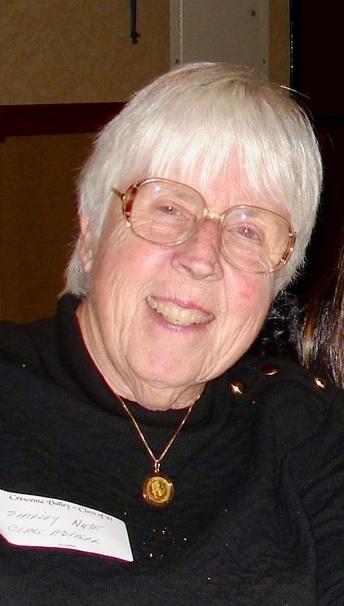
Shirley directed choirs at Crescenta Valley High School for 38 years of her 43 years as a high school director. She has received many awards for her choral work, most notable "The Howard Swan Award" from CCDA!
Then Shirley was interviewed by former student Lori Marie Rios (Director of Choral Activities at College of the Canyons) who met her some 43 years ago when she walked into the choir room at CVHS
BY TINA PAULSON
Greetings, colleagues! I hope your summer was full of all the activities that replenish and energize you; hiking, swimming, reading, or scrolling through social media for silly dog videos Maybe you ’ re like me and view summer as a time to “clean house”; purge the old things that have stacked up over the year, and make room for the new
This summer I tackled my personal/perusal choral library, and it only took me a few moments to get completely immersed in the rabbit hole of everything I have collected over the years. Working through the mire, I quickly realized I already have everything I need for nearly every aspect of my work Collected from workshops, clinics, masterclasses, conference sessionsit’s all already in my hands I found:
Sight reading and theory ideas/activities
Self-assessment tools for students and conductors
Articles on every aspect of singing SO MUCH music in perusal scores
Rep lists I haven’t looked at for ages because it was “easier” to get online and browse
I found myself continually thinking, “Oh yeah, I forgot about that!” “Oh, I remember this one now!” I also took the opportunity to recycle scores that I would never program and other materials don't serve me any more as I’ve grown and learned. Marie Kondo would have been proud.
Pulling scores from my treble repertoire folders, I set aside a few pieces I forgot that I knew - ones “from the vault ” From unison to SSAA divided, I offer these as starting points to maybe jog your own memory for pieces you ’ ve forgotten that you sang or conducted in the past
These aren’t representative of everything in “the vault,” but I hope these help you dig into what you already know, jog your memory, and launch you into the fall with some good ideas of your own. If you want to share your good ideas with me, I’d love to hear them. Or, if you want to know what else I found while I was cleaning like Dr Charlene Archibeque’s “Qualities of a Successful Choral Teacher/Conductor” or “Helping Your Administrator to Become a Better Evaluator” by Dr Tom Tatton, just reach out!
Unison
The Salley Gardens or The Birds
Benjamin Britten
Unison + piano
Britten is excellent for teaching line and vowels (while using English!) So much musicality is written into the score I’ve used both pieces with middle school treble choirs
Soprano-Alto
Laudate Pueri
Felix Mendelssohn
SSA + organ/piano
Great for intermediate groups; focuses on tone, technique (breath support for long lines), and understanding harmony as both linear and vertical. Mendelssohn is a melodic genius, as well.
Life Has Loveliness to Sell
Mary Lynn Lightfoot
SA/SSA + piano
With text by Sara Teasdale, I first encountered this piece as a MS student myself, and it has never left me I’ve taught it with beginning HS SSA choirs to introduce part independence and diction/text stress.
What Was I Made For?
arr Jennifer Lucy Cook
SSA + piano
Okay, I did this last year with my students and they LOVED it. I did, too. Heartfelt, poignant at any age for any person, takes some unexpected twists, and gives new context to the original pop song
SSAA
No Time
arr Susan Brumfield
SSAA +piano
This gorgeous and powerful arrangement has all the best parts of Camp Meeting songs Intonation is key, as is styleremembering what Alice Parker said: “only 5% of the ‘music’ is on the page ” Accessible for SSAA choirs of all walks of life
SSAA continued
Ngana
Stephen Leek
SSAA + percussion
Layered rhythm, diverse tone and timbre, and part independence make this a great choice in programming It looks easy on the page, but repetition and form can be challenging
Il est bel et bon
Pierre Passereau
arr Norman Greyson SSAA a cappella
Good old imitative polyphonic texture makes this piece fun for both audiences and singers! Character and expression are key in understanding the double meanings in the text If you can’t find it in print, John Leavitt has also arranged this piece which is nearly identical to the Norman Greyson version.
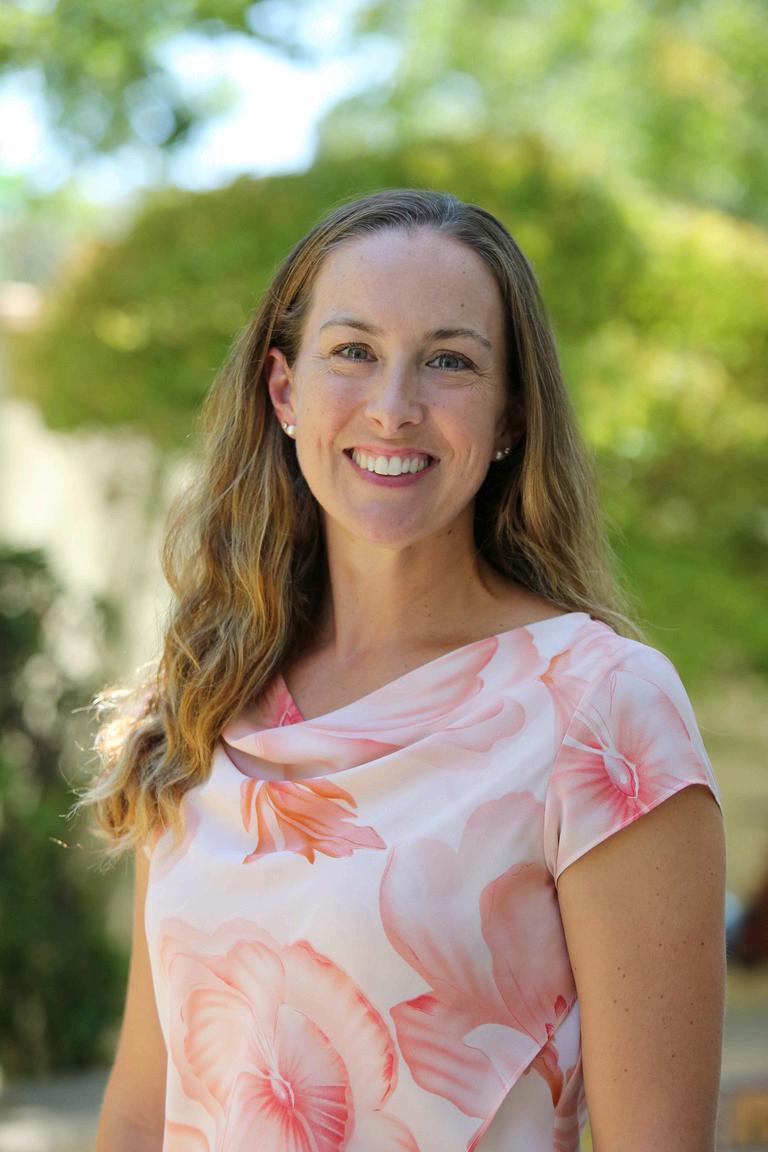
Tina Paulson holds a BM in Voice Performance from Washington State University, and Masters degrees in Voice Performance and Choral Conducting from San Jose State University, where she studied with Erie Mills, Dr. Charlene Archibeque, and Dr. Amanda Quist. As a music educator and program builder, she has taught
elementary, middle school, high school and community college choirs She is currently the Director of Music at Notre Dame High School, San Jose where she leads choir, band, strings, and music ministry ensembles Outside of teaching duties, Ms Paulson vocal/music directs musicals for Bay Area theater companies, and has served as a section leader for the Santa Clara Chorale since 2017. In between work and gigs, she loves to travel, run long-distance, hang out with her family, and read.
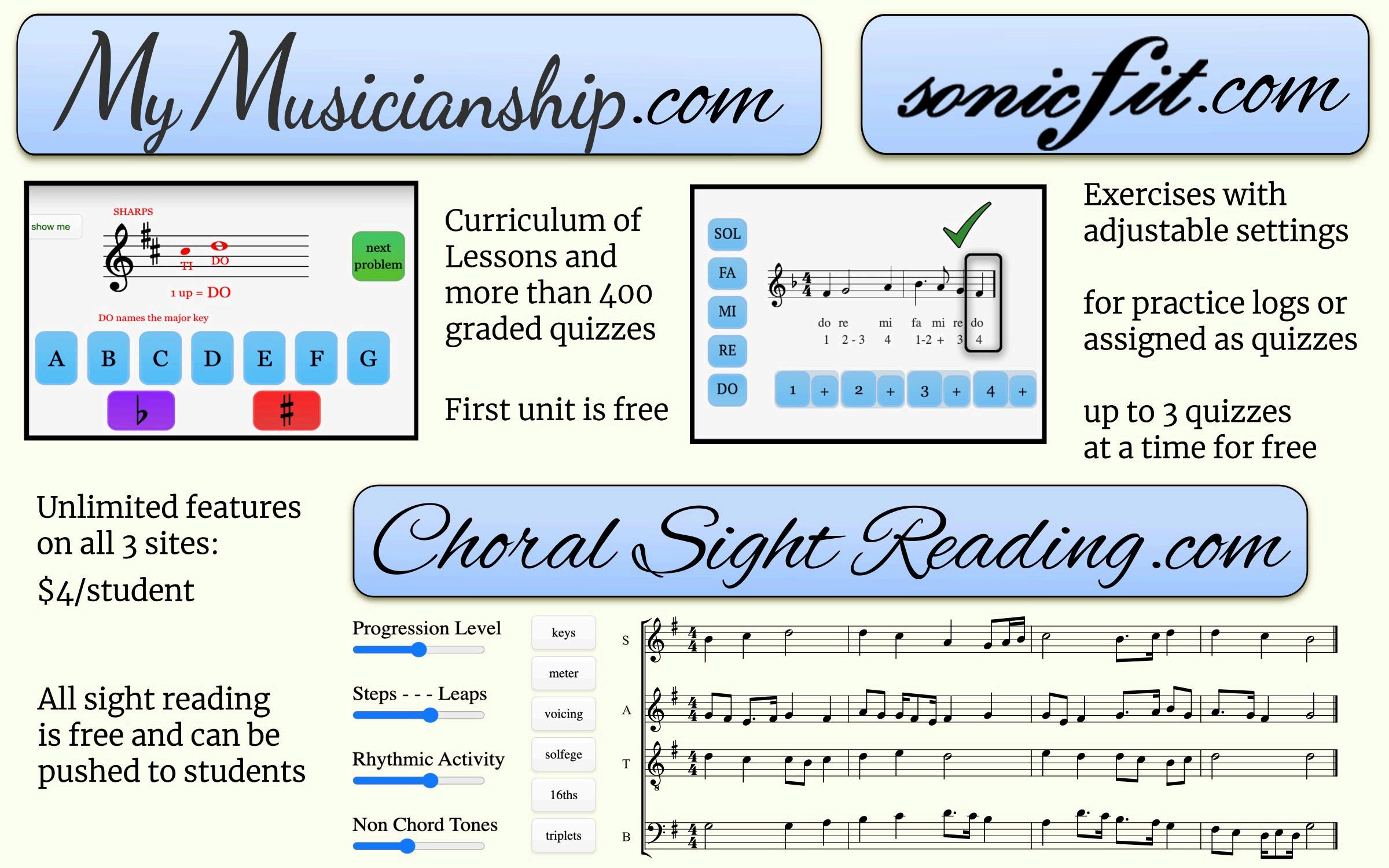
BY ANDREW HOWDEN
As we start off the 2024 academic year, here are a few pieces of repertoire for tenors and basses that I highly recommend for any choral program.
Danza, Danza, Fanciulla Gentile by Linda Spevacek
Great for any beginning TB choir, this fantastic arrangement that helps introduce a choir to this wellknown art song It is upbeat and fun so students enjoy learning the piece and the Italian is quite accessible
Dans Les Chantiers by Mark
Sirett
A slightly more challenging piece for a beginner TB choir that still allows them to be very successful for festival season, this is the piece for you! French language is a great way to incorporate variety into your program as well as help your students learn a new approach to phrasing as they work with the language and fairly simple rhythms
Fields of Gold by Ethan Sperry
Another great piece for a pop-style concert, this piece provides a great chance for students to learn how to tune some tricky chords while also enjoying a fun, lyrical melody.
Mis on inimene?
by Pärt Uusberg
A great opportunity to expose students to a very different language and approach to choral music as it is written in Estonian More advanced TB choirs can flourish as they learn the beautiful harmonies, long phrases, and mixed meter A gorgeous piece for any choir that wants a little bit of a challenge but still something that is very doable. There is also a great pronunciation guide on the GIA music website to help in learning/teaching the Estonian
Noel by Brad Holmes
4-part TTBB
A fairly repetitive and easy piece to put together It is a fun, upbeat piece that students will be sure to enjoy!
O Love by Elaine Hagenberg
4-part
TTBB
A gorgeous piece and provides a chance to incorporate a cello accompaniment along with the piano
Regina Coeli by Dan Davison
Another great piece for beginner TB choirs as it is written for two parts and has accessible ranges This piece is written in Latin and works great for a festival opener where the students can demonstrate a wide variety of articulations.
Rozszumialy sie Wierzby Placzace by Derek J. Myler
A Polish piece with clapping and stomping alongside the vocal lines Well-organized scaffolding will allow your students to be successful and enjoy this piece
Tell My Father by Andrea Ramsey
A great addition to a pop-style or musical theater-style concert Arranged from the musical “The Civil War: An American Musical,” your singers will fall in love with the beautiful melody and harmonies as the piece provides a stark reality of war.
What Shall We Sing for the Child? by Howard Helvey
For a slightly more advanced TB choir, this piece works wonderfully if a more sacred piece is needed for a winter/holiday/Christmas concert Helvey wrote a wonderful 4-hand piano accompaniment that is smooth and compliments the voices well.
BY ÁNGEL VÁZQUEZ-RAMOS
I am Ángel Vázquez-Ramos (from Puerto Rico) and I am excited to be the World Music & Cultures Repertoire and Resources, Chair for Western ACDA. I accepted the invitation to serve in this capacity because it represents an opportunity to keep learning and sharing about choral music from other cultures To be clear, I am not an expert in choral music from all countries and traditions around the world, however, I hope to share with you some of the things I have learned and those I will learn from you. If you feel like sharing your knowledge (repertoire, performance practices, etc ) with me, I would gladly accept it
So, what can you expect from me? I am looking forward to interviewing culture bearers from several countries and sharing those in the form of video and/or written articles in Tactus and the website These short interviews will focus on performance practices, repertoire ideas,
introducing new composers, diction, and historical background, etc. The first interview will focus on the choral music from Brazil with Dr. Daniel Afonso Jr.!
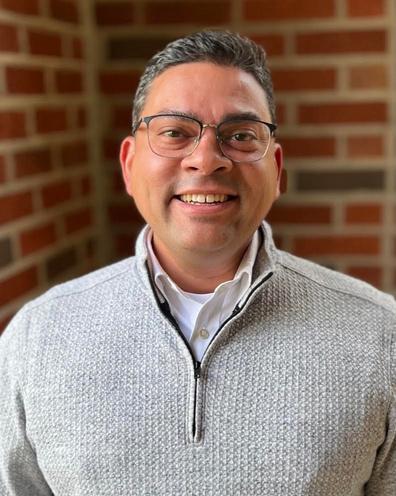
Dr. Vázquez-Ramos, a native of Carolina, Puerto Rico is Director of Choral & Vocal Studies and Professor of Music at California State University, Bakersfield. He teaches undergraduate courses in music education, choral conducting, and conducts the University Singers and Chamber Singers. Dr. Vázquez-Ramos is the co-founder and co-director of the CSUB Kodály Institute, and founding artistic music director of Meridian Voices, a chamber choral ensemble based in Bakersfield He maintains an active schedule as a guest conductor, adjudicator, and clinician Additionally, he established La Voz Music Publishing, a music publishing company dedicated to Latin American choral music
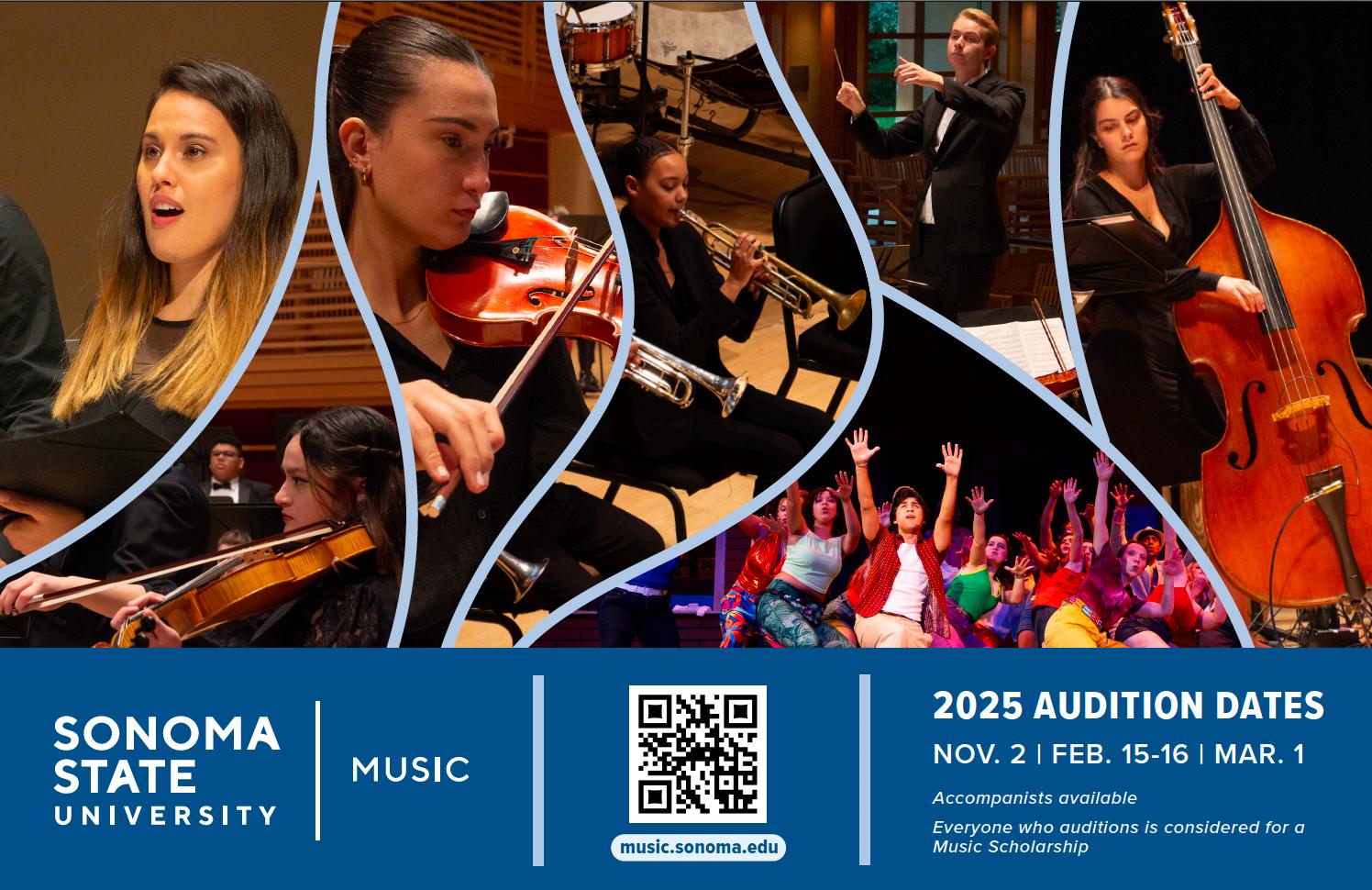
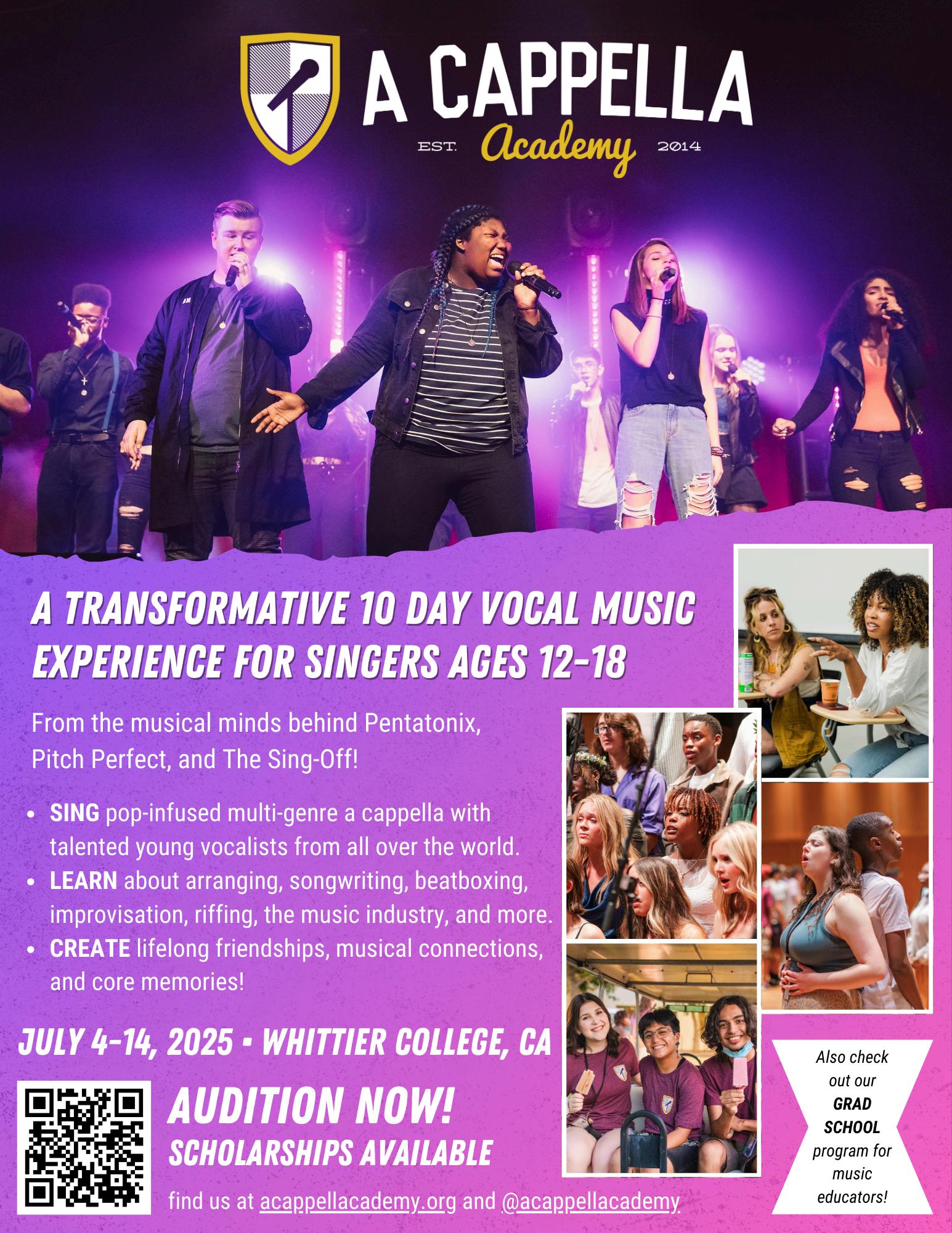
BY MARYANNE MUGLIA SMITH
This collection of contemporary a cappella arrangements offers a variety of styles and levels, ensuring that choirs of all abilities can find something exciting and engaging to perform. From pop hits to timeless classics, these arrangements will help choirs connect with audiences and showcase their vocal talents.
Beginning/Early Intermediate Level
Dance Monkey
by Toni Watson, arr. Bryan Sharpe
SAB
A viral hit brings infectious energy to any performance
The catchy melody and rhythm is maintained throughout, making it an excellent choice for beginning choirs looking to engage audiences.
Kings & Queens by Ava Max, arr. BK Riha
SATB
An empowering anthem brought to life in a dynamic arrangement It's an excellent piece for choirs looking to add a modern pop song to their repertoire
The Way I Am by Ingrid Michaelson, arr MaryAnne Muglia
SATB/SSA
A heartfelt song beautifully arranged with tender lyrics and simple yet captivating melody.
Tonight You Belong to Me arr Katherine Bodor
SSAB
A classic tune famously covered by Steve Martin and Bernadette Peters. It offers a nostalgic and charming experience, perfect for early intermediate ensembles
Wellerman arr. MaryAnne Muglia
TTB/SSA
A traditional sea shanty that gained popularity on social media Its rhythmic drive and catchy melody make it fun and engaging!
When the Party’s Over by Billie Eilish, arr Rob Dietz
SSAB
A haunting ballad perfect for SSAB choirs seeking a modern and emotionally resonant piece.
Intermediate Level
Can’t Stop the Feeling from “Trolls”
arr. Ben Bram
SATB
Justin Timberlake's upbeat "Can't Stop the Feeling" is a vibrant addition to any SATB choir's repertoire, sure to get audiences dancing along
Color Song
by Maggie Rogers, arr Celine Durney for SSA Choirs
Captures the ethereal and emotional essence of the original, making it a beautiful addition for SSA choirs
Espresso by Sabrina Carpenter, arr MaryAnne Muglia & Kate Crellin
SSAA Choirs
A lively and engaging piece that offers a fun and rhythmic challenge for intermediate choirs.
Fortnight by Taylor Swift, arr. Rob Dietz
SATB
A stunning SATB arrangement that offers choirs a contemporary piece with heartfelt lyrics and intricate vocal lines
Lift Me Up from “Wakanda Forever”
arr Emily Drum
SATB/SSAA
A powerful piece excellent choice for choirs looking to perform a song with deep emotional resonance.
Made You Look
by Meghan Trainor, arr. BK Riha
An upbeat and catchy song perfect for choirs wanting to add a pop flair to their performances.
Put Your Records On
arr. David Das
SSAA
A soulful hit with a fresh take, perfect for choirs looking to showcase smooth harmonies
We All Need Saving by Jonathan Michael McLaughlin, arr Rob Dietz
TTBB
Perfect for TTBB choirs seeking a piece with a strong emotional impact and beautiful harmonies.
We Can’t Be Friends by Ariana Grande, arr MaryAnne Muglia & Kate Crellin SSAA
Ariana Grande's "We Can’t Be Friends" is transformed into a captivating arrangement suitable for choirs looking for contemporary pop repertoire
With a Little Help from My Friends by The Beatles, arr. Kate Crellin SATB
This Beatles classic offers a nostalgic and harmonically rich experience for SATB choirs It’s a wonderful piece for building community through music
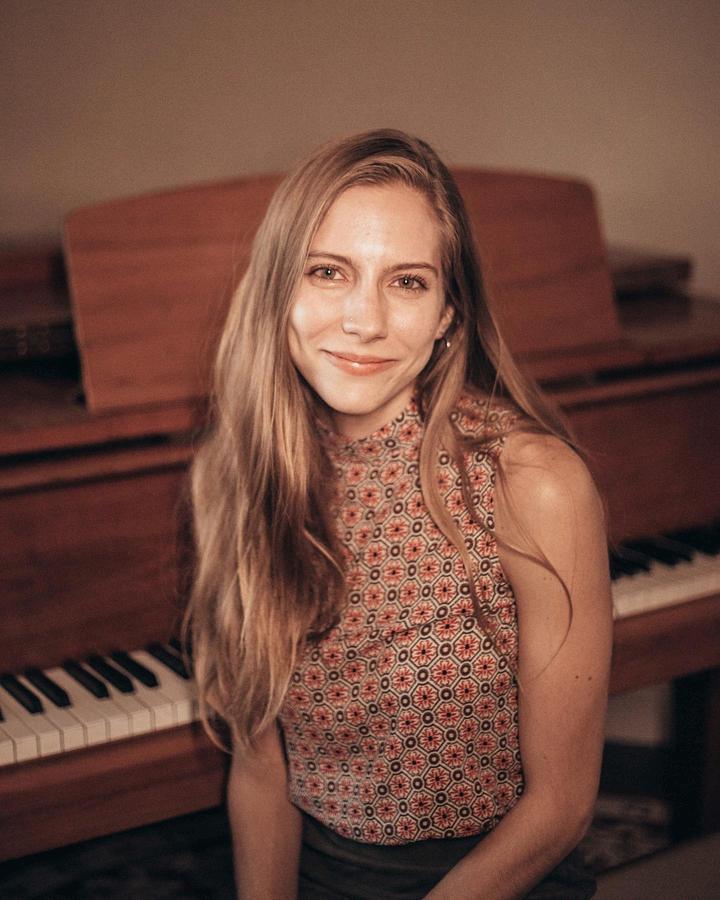
MaryAnne Muglia is a singer, arranger, composer, and educator from Mesa, AZ Her love for and understanding of harmony, particularly in vocal contexts, blossomed in her childhood and has only deepened over time. Her versatility shines through her writing in both contemporary and classical choral genres. With a keen musical ear, diverse taste, and distinctive vocal style, she excels as a singer, arranger, director, and musician
MaryAnne's involvement in the contemporary a cappella scene has significantly enriched her artistic journey as an arranger, producer, and vocalist As a member of the NAU Axecientals and Northern Arizona Unaccompanied, she and her groups achieved notable success in the International Championship of Collegiate A Cappella, earning the 'Outstanding Arrangement' award on three separate occasions, and advancing to semifinals three years in a row
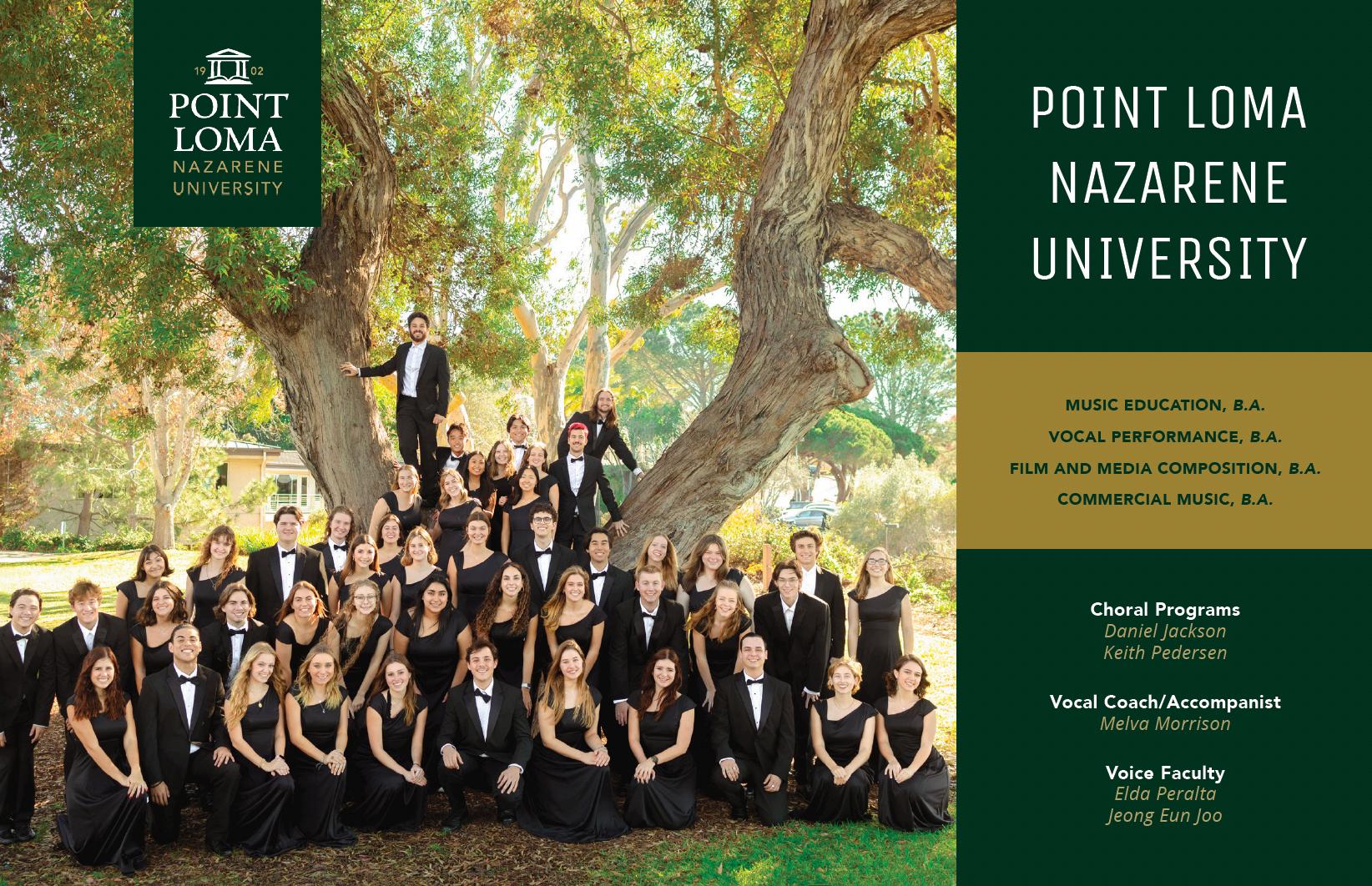
LYNN ATKINS
These terms strike each of us differently. In some of my conversations with our fellow colleagues, I understand the hesitation that one might feel when entering a conversation or a workshop where attempting to grapple with these ideas It is in the spirit of positive collaboration that I am so excited to serve the Western Region ACDA family as the Chair of our Diversity, Equity and Inclusion (DEI) Initiatives Committee.
It is my hope that over this term, this team of choral enthusiasts who are sensitive to these ideas will be able to help you in your work. Whether your goal is to include repertoire or to find strategies that will allow your choirs to enrich their understanding of the world they live in and the people who exist outside of their classroom, we desire to help you become ready to take on this task My colleagues and I look forward to bringing you repertoire and strategies to help you and your musicians create art that welcomes each person to have an experience that respects everyone in the room while building a rich, varied musical presentation for the audience
I hope that through the work of many others before this team, we all understand that being diverse is not enough. I find myself constantly thinking about a quote from a book called Culturally Proficient Instruction, “Diversity is as ever-present as the air we breathe To ask, ‘Do you believe in diversity?’ is as tantamount to asking, ‘Do you believe in the sun?’ Diversity is not something to believe in. It exists”. Diversity, or the practice of gathering people, ideas, or things from different backgrounds, is the all-important “first step” that is taken intentionally, that requires one to recognize that the choral canon is more than any one group of composers or schools of thought. Diversity is how we connect our classrooms to the musical world that exists outside of our classroom, whether it is down
the street at the local music gazebo or thousands of miles away in a small community that doesn’t share our native language.
When we intentionally include music as well as music education techniques outside of the classical western canon, we begin to create the steps that allow equity to truly exist. Inclusion is the intentional welcoming of opportunities and resources for genres and styles that might otherwise be excluded or marginalized. Equity is the creation of systems that allow the whole group (choir, classroom members, etc ) the ability to acquire information When inclusion of varied techniques with modification for those who need additional help is presented to our musicians, they can acquire the material at hand and create a positive internalization of that material Whether we choose to teach the music of J S Bach or a Zulu folk song, both pieces are built of the same elements of music The composition deserves a concrete teaching strategy that acknowledges the composer ’ s intent.
When we find the keys that allow access to the musical language that we share together, we are not just creating concert programs that serve the greater human community. This investigation of understanding what tools we should provide, remove, or create to ensure equitable acquisition of musical knowledge is the most necessary step in this process When we provide access for our musicians and audience members, it is our way of saying to each chorus member and each ticket holder that your existence here in this moment is vital to the existence of the ensemble.
Let me close by saying that this work does require us to be more intentional Choral directors can expect to spend more time thinking on these principles, maybe
even to the point of overthinking I once again encourage you to have conversations with us, with your fellow colleagues We should not expect each other to tackle this problem in one concert or even one school year. Normalizing the principles of DEI into your classroom will take time. It requires each of us to commit to learning more about each student in our classroom, searching for repertoire that is developmentally appropriate, and creating the multilayered pathways for growth in creating diversity, extending invitations for inclusion, and creating equitable avenues for access. It is not enough for us to just talk this talk; we must walk this walk for our choristers and our audiences
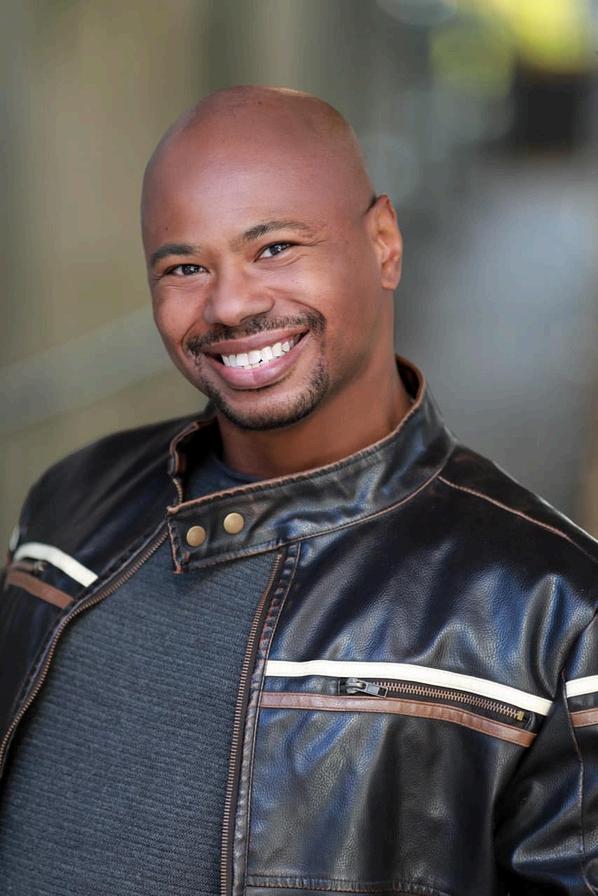
Lynn G Atkins Jr ’ s (he/him) passion for DEI began with his tenure as Artistic Director of One Voice Chorus Richmond, a choral organization in central Virginia that uses choral music to bridge the racial divide in the former capitol of the confederacy He is proud to share these skills with the Western Division of ACDA as DEI Initiatives Chair Dr Atkins is Director of Choral Activities and Voice Area Coordinator for California State University Dominguez Hills in Carson, CA; where he teaches courses in music education, choral methods, and applied voice. A son of the Jersey shore, Lynn received a Bachelor of Music degree in Music Education from Westminster Choir College of Rider University In 2012, he was a member of the first cohort to receive a Doctor of Musical Arts degree in Choral Conducting Performance, Pedagogy, and Literature from James Madison University in Harrisonburg, VA. Lynn and his partner Russell love to joke that they traded the Atlantic Ocean for the Pacific Ocean, as they call El Segundo, CA, home

FORWARD BY MICHAEL SHORT
On June 7th, 2024 we lost one of our great leaders and mentors. At our last Western Region ACDA Conference, March 2024, Joe Huszti was our honoree. None of us knew at that time that he was sick and that his passing was so close. I am glad that we had a chance to let him know that he was held in such high esteem and regard by the profession that he helped to inspire and advance It was an honor to have him engaged in workshops and sharing his knowledge of our choral art in this one last event! He was engaging and eloquent during the conference! He was a bright light in our choral world
Although I never studied with Joe, my daughter did Although Katie was not a music major at UCI she traveled the world with him as a choir member and helped Joe and Melinda with the Madrigal Dinners. They were a wonderful influence in her life and helped to make her the amazing person she is today. The kindness and caring of his nature were evident to all that he met and worked with. Not only was he a consummate musician and choral educator but he inspired leadership in all students he touched. He will be missed, but his influence will be felt in the choral world for generations to come.
Joseph Béla Huszti,internationally renowned choral conductor and beloved father, teacher, and friend, died peacefully at his home in Irvine, California, on June 7, 2024, after a brief illness.
Born to a family of Hungarian origin in Ohio, on September 27, 1936, Joe distinguished himself as a gifted musician from an early age, playing violin and directing his first church choir at age 6 or 7, and he earned his bachelor’s and master’s degrees in music from Northwestern University. He married Melinda Murray on August 15, 1959, and that fall began his tenure at Bakersfield Junior College in central California, and their daughter Heather was born in 1960 In 1965, his Bakersfield College Choir became the first American ensemble to win first prize in the International Musical Eisteddfod in Llangollen, Wales an achievement that earned them nationwide headlines and audiences with President Lyndon Johnson and Pope Paul VI A documentary film, One Heart, One Voice, about the choir and its international adventures was produced in 2017
He held positions at the University of Delaware, Boston University, and the
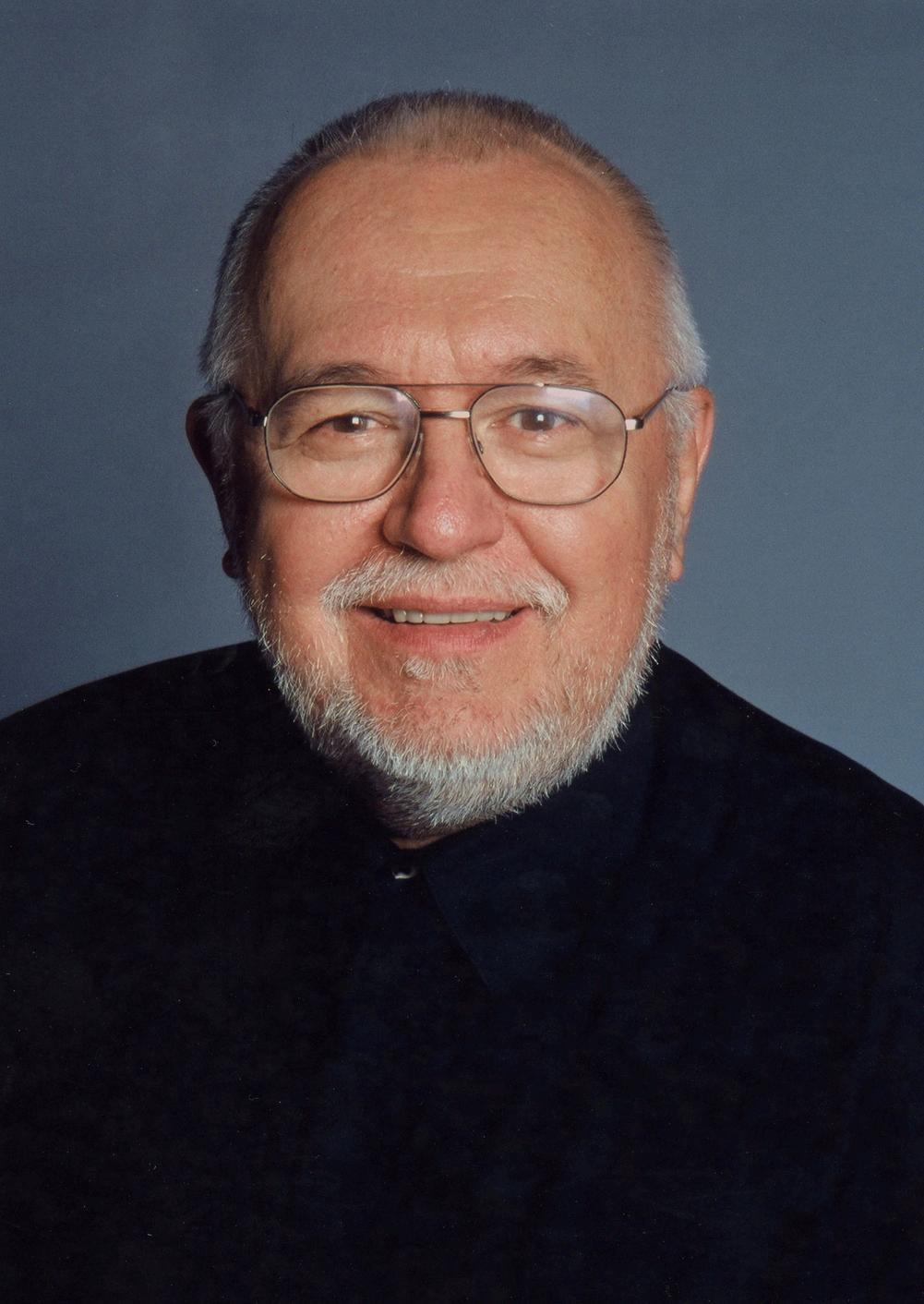
Tanglewood Summer Institute, before moving to the University of California–Irvine in 1977; he remained there until his retirement in 2016. He made 30 international choir tours with the UCI choirs and won dozens of major prizes at competitions around the world, and received the UCI Distinguished University Service Award and multiple teaching awards In 1979, Joe and Melinda joined forces to begin the annual Madrigal Dinner tradition at UCI, complete with Renaissance costumes, knighting ceremonies, and an authentic meal topped with cups of wassail; alums who took part in the Madrigal Dinners over the course of three decades still break into song and greet each other with “Huzzah!” when they meet
In 1997, Joe formed Men in Blaque, a select male-voice ensemble composed of UCI alums and other talented singers. Men in Blaque also made multiple international tours, and brought home prizes from such events as the World Choir Games (China, 2006), the Yeosu International Choral Competition (South Korea, 2013), and the International Musical Eisteddfod (Wales, 2017). Joe continued to conduct Men in Blaque until months before his passing.
The California Choral Directors’ Association awarded Joe its highest honor, the Howard Swan Award (named for one of Joe’s own most influential mentors), in July 2020 In March of 2024, the Western Region of the American Choral Directors’ Association named him as the honoree of its biannual conference
Joe’s prizes and laurels, however, meant less to him than his six decades of students their professional successes (in and out of the choral world), their
personal integrity, and the multi-generational extended family they formed by virtue of having sung, sometime and somewhere, in one of his choirs Neither he nor Melinda ever forgot the name of (or the anecdotes associated with) a former singer, and their partnership and mutual devotion made them surrogate parents for hundreds of students over the years UCI choir alums gathered regularly for concerts, reunions, or meals at the Huszti home, and they gathered to celebrate and remember Melinda, his partner in life and musicmaking, after her death in December 2021.
Joe was a man of boundless curiosity, endless questions, head-spinning creativity, dizzying passions, and profound, sensitive, inspired artistry He was a natural teacher delighted in improving people’s knowledge and skills on seemingly any topic He expostulated from time to time in Hungarian, made singers throw imaginary frisbees or pretend to be giant kelp, and referred regularly to his beloved Cleveland sports teams in his choral rehearsals. (He joyfully participated several times in Cleveland Guardians Fantasy Camp, where he was
proud to have gotten a hit off Hall of Famer Bob Feller, who was 18 years his senior but still throwing heat.) He spent many summers on the family farm in Ohio enjoying his great nieces and nephews, perfecting his garden, blackberry picking, and giving tours of the elk farm He cheerfully welcomed “outsiders” to his musical table; he was proud to keep “shaking up ” the choral world well into his 80s; and his artistic to-do list never ran out of items. As one former-student-turned-friend said after a visit during the last week of Joe’s life, “We all wanted to talk to him about the past. He was still talking about the future.”
Joseph Huszti was preceded in death by his wife and soulmate, Melinda He is survived by their daughter, Heather Huszti; by his brother, Allen Huszti; by his sisterin-law, Maribelle Donaldson; by his nieces, Erin Paul and Hannah Huszti; by his nephews, Benjamin Paul and Douglas Huszti; by his grand- nieces Maggie, Emily, and Lia Huszti, Anna Adeoye, and Myra Paul, and grandnephews Alex Huszti, Wole Adeoye, and Miller Paul; and by the thousands of students who found their voices in his choirs
BY HEATHER HUSZTI AND ELIZA RUBENSTEIN
